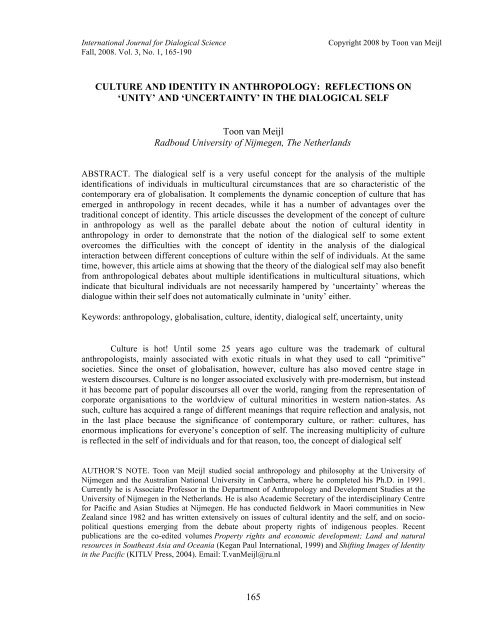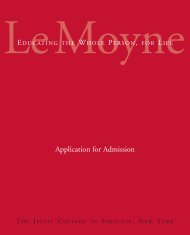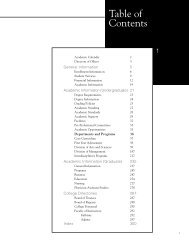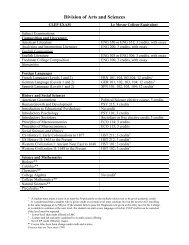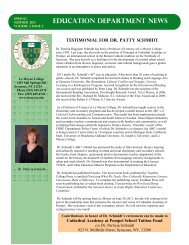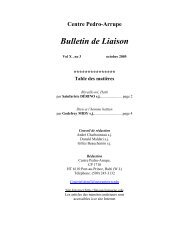165 culture and identity in anthropology: reflections on 'unity'
165 culture and identity in anthropology: reflections on 'unity'
165 culture and identity in anthropology: reflections on 'unity'
You also want an ePaper? Increase the reach of your titles
YUMPU automatically turns print PDFs into web optimized ePapers that Google loves.
Internati<strong>on</strong>al Journal for Dialogical ScienceFall, 2008. Vol. 3, No. 1, <str<strong>on</strong>g>165</str<strong>on</strong>g>-190Copyright 2008 by To<strong>on</strong> van MeijlCULTURE AND IDENTITY IN ANTHROPOLOGY: REFLECTIONS ON‘UNITY’ AND ‘UNCERTAINTY’ IN THE DIALOGICAL SELFTo<strong>on</strong> van MeijlRadboud University of Nijmegen, The Netherl<str<strong>on</strong>g>and</str<strong>on</strong>g>sABSTRACT. The dialogical self is a very useful c<strong>on</strong>cept for the analysis of the multipleidentificati<strong>on</strong>s of <str<strong>on</strong>g>in</str<strong>on</strong>g>dividuals <str<strong>on</strong>g>in</str<strong>on</strong>g> multicultural circumstances that are so characteristic of thec<strong>on</strong>temporary era of globalisati<strong>on</strong>. It complements the dynamic c<strong>on</strong>cepti<strong>on</strong> of <str<strong>on</strong>g>culture</str<strong>on</strong>g> that hasemerged <str<strong>on</strong>g>in</str<strong>on</strong>g> <str<strong>on</strong>g>anthropology</str<strong>on</strong>g> <str<strong>on</strong>g>in</str<strong>on</strong>g> recent decades, while it has a number of advantages over thetraditi<strong>on</strong>al c<strong>on</strong>cept of <str<strong>on</strong>g>identity</str<strong>on</strong>g>. This article discusses the development of the c<strong>on</strong>cept of <str<strong>on</strong>g>culture</str<strong>on</strong>g><str<strong>on</strong>g>in</str<strong>on</strong>g> <str<strong>on</strong>g>anthropology</str<strong>on</strong>g> as well as the parallel debate about the noti<strong>on</strong> of cultural <str<strong>on</strong>g>identity</str<strong>on</strong>g> <str<strong>on</strong>g>in</str<strong>on</strong>g><str<strong>on</strong>g>anthropology</str<strong>on</strong>g> <str<strong>on</strong>g>in</str<strong>on</strong>g> order to dem<strong>on</strong>strate that the noti<strong>on</strong> of the dialogical self to some extentovercomes the difficulties with the c<strong>on</strong>cept of <str<strong>on</strong>g>identity</str<strong>on</strong>g> <str<strong>on</strong>g>in</str<strong>on</strong>g> the analysis of the dialogical<str<strong>on</strong>g>in</str<strong>on</strong>g>teracti<strong>on</strong> between different c<strong>on</strong>cepti<strong>on</strong>s of <str<strong>on</strong>g>culture</str<strong>on</strong>g> with<str<strong>on</strong>g>in</str<strong>on</strong>g> the self of <str<strong>on</strong>g>in</str<strong>on</strong>g>dividuals. At the sametime, however, this article aims at show<str<strong>on</strong>g>in</str<strong>on</strong>g>g that the theory of the dialogical self may also benefitfrom anthropological debates about multiple identificati<strong>on</strong>s <str<strong>on</strong>g>in</str<strong>on</strong>g> multicultural situati<strong>on</strong>s, which<str<strong>on</strong>g>in</str<strong>on</strong>g>dicate that bicultural <str<strong>on</strong>g>in</str<strong>on</strong>g>dividuals are not necessarily hampered by ‘uncerta<str<strong>on</strong>g>in</str<strong>on</strong>g>ty’ whereas thedialogue with<str<strong>on</strong>g>in</str<strong>on</strong>g> their self does not automatically culm<str<strong>on</strong>g>in</str<strong>on</strong>g>ate <str<strong>on</strong>g>in</str<strong>on</strong>g> ‘unity’ either.Keywords: <str<strong>on</strong>g>anthropology</str<strong>on</strong>g>, globalisati<strong>on</strong>, <str<strong>on</strong>g>culture</str<strong>on</strong>g>, <str<strong>on</strong>g>identity</str<strong>on</strong>g>, dialogical self, uncerta<str<strong>on</strong>g>in</str<strong>on</strong>g>ty, unityCulture is hot! Until some 25 years ago <str<strong>on</strong>g>culture</str<strong>on</strong>g> was the trademark of culturalanthropologists, ma<str<strong>on</strong>g>in</str<strong>on</strong>g>ly associated with exotic rituals <str<strong>on</strong>g>in</str<strong>on</strong>g> what they used to call “primitive”societies. S<str<strong>on</strong>g>in</str<strong>on</strong>g>ce the <strong>on</strong>set of globalisati<strong>on</strong>, however, <str<strong>on</strong>g>culture</str<strong>on</strong>g> has also moved centre stage <str<strong>on</strong>g>in</str<strong>on</strong>g>western discourses. Culture is no l<strong>on</strong>ger associated exclusively with pre-modernism, but <str<strong>on</strong>g>in</str<strong>on</strong>g>steadit has become part of popular discourses all over the world, rang<str<strong>on</strong>g>in</str<strong>on</strong>g>g from the representati<strong>on</strong> ofcorporate organisati<strong>on</strong>s to the worldview of cultural m<str<strong>on</strong>g>in</str<strong>on</strong>g>orities <str<strong>on</strong>g>in</str<strong>on</strong>g> western nati<strong>on</strong>-states. Assuch, <str<strong>on</strong>g>culture</str<strong>on</strong>g> has acquired a range of different mean<str<strong>on</strong>g>in</str<strong>on</strong>g>gs that require reflecti<strong>on</strong> <str<strong>on</strong>g>and</str<strong>on</strong>g> analysis, not<str<strong>on</strong>g>in</str<strong>on</strong>g> the last place because the significance of c<strong>on</strong>temporary <str<strong>on</strong>g>culture</str<strong>on</strong>g>, or rather: <str<strong>on</strong>g>culture</str<strong>on</strong>g>s, hasenormous implicati<strong>on</strong>s for every<strong>on</strong>e’s c<strong>on</strong>cepti<strong>on</strong> of self. The <str<strong>on</strong>g>in</str<strong>on</strong>g>creas<str<strong>on</strong>g>in</str<strong>on</strong>g>g multiplicity of <str<strong>on</strong>g>culture</str<strong>on</strong>g>is reflected <str<strong>on</strong>g>in</str<strong>on</strong>g> the self of <str<strong>on</strong>g>in</str<strong>on</strong>g>dividuals <str<strong>on</strong>g>and</str<strong>on</strong>g> for that reas<strong>on</strong>, too, the c<strong>on</strong>cept of dialogical selfAUTHOR’S NOTE. To<strong>on</strong> van Meijl studied social <str<strong>on</strong>g>anthropology</str<strong>on</strong>g> <str<strong>on</strong>g>and</str<strong>on</strong>g> philosophy at the University ofNijmegen <str<strong>on</strong>g>and</str<strong>on</strong>g> the Australian Nati<strong>on</strong>al University <str<strong>on</strong>g>in</str<strong>on</strong>g> Canberra, where he completed his Ph.D. <str<strong>on</strong>g>in</str<strong>on</strong>g> 1991.Currently he is Associate Professor <str<strong>on</strong>g>in</str<strong>on</strong>g> the Department of Anthropology <str<strong>on</strong>g>and</str<strong>on</strong>g> Development Studies at theUniversity of Nijmegen <str<strong>on</strong>g>in</str<strong>on</strong>g> the Netherl<str<strong>on</strong>g>and</str<strong>on</strong>g>s. He is also Academic Secretary of the <str<strong>on</strong>g>in</str<strong>on</strong>g>terdiscipl<str<strong>on</strong>g>in</str<strong>on</strong>g>ary Centrefor Pacific <str<strong>on</strong>g>and</str<strong>on</strong>g> Asian Studies at Nijmegen. He has c<strong>on</strong>ducted fieldwork <str<strong>on</strong>g>in</str<strong>on</strong>g> Maori communities <str<strong>on</strong>g>in</str<strong>on</strong>g> NewZeal<str<strong>on</strong>g>and</str<strong>on</strong>g> s<str<strong>on</strong>g>in</str<strong>on</strong>g>ce 1982 <str<strong>on</strong>g>and</str<strong>on</strong>g> has written extensively <strong>on</strong> issues of cultural <str<strong>on</strong>g>identity</str<strong>on</strong>g> <str<strong>on</strong>g>and</str<strong>on</strong>g> the self, <str<strong>on</strong>g>and</str<strong>on</strong>g> <strong>on</strong> sociopoliticalquesti<strong>on</strong>s emerg<str<strong>on</strong>g>in</str<strong>on</strong>g>g from the debate about property rights of <str<strong>on</strong>g>in</str<strong>on</strong>g>digenous peoples. Recentpublicati<strong>on</strong>s are the co-edited volumes Property rights <str<strong>on</strong>g>and</str<strong>on</strong>g> ec<strong>on</strong>omic development; L<str<strong>on</strong>g>and</str<strong>on</strong>g> <str<strong>on</strong>g>and</str<strong>on</strong>g> naturalresources <str<strong>on</strong>g>in</str<strong>on</strong>g> Southeast Asia <str<strong>on</strong>g>and</str<strong>on</strong>g> Oceania (Kegan Paul Internati<strong>on</strong>al, 1999) <str<strong>on</strong>g>and</str<strong>on</strong>g> Shift<str<strong>on</strong>g>in</str<strong>on</strong>g>g Images of Identity<str<strong>on</strong>g>in</str<strong>on</strong>g> the Pacific (KITLV Press, 2004). Email: T.vanMeijl@ru.nl<str<strong>on</strong>g>165</str<strong>on</strong>g>
VAN MEIJLseems very useful to address the different <str<strong>on</strong>g>and</str<strong>on</strong>g> even oppos<str<strong>on</strong>g>in</str<strong>on</strong>g>g dem<str<strong>on</strong>g>and</str<strong>on</strong>g>s result<str<strong>on</strong>g>in</str<strong>on</strong>g>g fromthe differentiati<strong>on</strong> of <str<strong>on</strong>g>culture</str<strong>on</strong>g> <str<strong>on</strong>g>in</str<strong>on</strong>g> the c<strong>on</strong>text of globalisati<strong>on</strong> <str<strong>on</strong>g>and</str<strong>on</strong>g> its associated processesof migrati<strong>on</strong>.Indeed, the prom<str<strong>on</strong>g>in</str<strong>on</strong>g>ence of <str<strong>on</strong>g>culture</str<strong>on</strong>g> <str<strong>on</strong>g>in</str<strong>on</strong>g> the c<strong>on</strong>temporary era seems itself a culturalphenomen<strong>on</strong> that cannot be analysed <str<strong>on</strong>g>in</str<strong>on</strong>g> isolati<strong>on</strong> of the unprecendented impact ofglobalisati<strong>on</strong>. When the impact of <str<strong>on</strong>g>in</str<strong>on</strong>g>novati<strong>on</strong>s <str<strong>on</strong>g>in</str<strong>on</strong>g> communicati<strong>on</strong> technology gatheredsome momentum <str<strong>on</strong>g>and</str<strong>on</strong>g> the rise of neo-liberal ideologies seemed irreversible, theemergence of globalisati<strong>on</strong> became rapidly unc<strong>on</strong>tested <str<strong>on</strong>g>in</str<strong>on</strong>g> the 1980s. Initially, somepessimists still predicted that globalisati<strong>on</strong> would entail an <str<strong>on</strong>g>in</str<strong>on</strong>g>creas<str<strong>on</strong>g>in</str<strong>on</strong>g>g homogenisati<strong>on</strong>of customs <str<strong>on</strong>g>and</str<strong>on</strong>g> <str<strong>on</strong>g>culture</str<strong>on</strong>g>s throughout the world (Ritzer, 1992), but some 15 years later itis no l<strong>on</strong>ger disputed that globalisati<strong>on</strong> seems to <str<strong>on</strong>g>in</str<strong>on</strong>g>volve <str<strong>on</strong>g>in</str<strong>on</strong>g>creas<str<strong>on</strong>g>in</str<strong>on</strong>g>g heterogeneity<str<strong>on</strong>g>in</str<strong>on</strong>g>stead (Appadurai, 2001). After all, <str<strong>on</strong>g>in</str<strong>on</strong>g> c<strong>on</strong>trast to earlier expectati<strong>on</strong>s globalisati<strong>on</strong> has<str<strong>on</strong>g>in</str<strong>on</strong>g>cited a large-scale revival of cultural traditi<strong>on</strong>s at local levels.The so-called paradox of globalisati<strong>on</strong> is particularly evident <str<strong>on</strong>g>in</str<strong>on</strong>g> small-scalesocieties that believe to be <str<strong>on</strong>g>in</str<strong>on</strong>g> danger of los<str<strong>on</strong>g>in</str<strong>on</strong>g>g their cultural uniqueness under the impactof global <str<strong>on</strong>g>in</str<strong>on</strong>g>fluences, as a c<strong>on</strong>sequence of which they have become engaged <str<strong>on</strong>g>in</str<strong>on</strong>g> a largescalerevival of cultural traditi<strong>on</strong>s (Otto & Pedersen, 2000, 2005). The rec<strong>on</strong>stituti<strong>on</strong> oflocal traditi<strong>on</strong>s <str<strong>on</strong>g>and</str<strong>on</strong>g> traditi<strong>on</strong>al forms of <str<strong>on</strong>g>culture</str<strong>on</strong>g> <str<strong>on</strong>g>in</str<strong>on</strong>g> many n<strong>on</strong>-western societies, however,could also be argued as po<str<strong>on</strong>g>in</str<strong>on</strong>g>t<str<strong>on</strong>g>in</str<strong>on</strong>g>g to a decl<str<strong>on</strong>g>in</str<strong>on</strong>g><str<strong>on</strong>g>in</str<strong>on</strong>g>g hegem<strong>on</strong>y of western capitalism(Friedman, 2003). This suggesti<strong>on</strong> is further corroborated by a parallel upsurge of aseries of alternative cultural identificati<strong>on</strong>s <str<strong>on</strong>g>in</str<strong>on</strong>g> many western societies, such as thosebased <strong>on</strong> <str<strong>on</strong>g>in</str<strong>on</strong>g>digenousness, regi<strong>on</strong>al locati<strong>on</strong> <str<strong>on</strong>g>and</str<strong>on</strong>g> immigrant status, which all have anegative <str<strong>on</strong>g>in</str<strong>on</strong>g>fluence <strong>on</strong> the capacity of nati<strong>on</strong>-states to nati<strong>on</strong>alize.The fragmentati<strong>on</strong> of the nati<strong>on</strong>-state <str<strong>on</strong>g>in</str<strong>on</strong>g> the global era is to a large extent causedby migrati<strong>on</strong>. C<strong>on</strong>temporary movements of labour are fundamentally different fromthose <str<strong>on</strong>g>in</str<strong>on</strong>g> the past, both <str<strong>on</strong>g>in</str<strong>on</strong>g> terms of quantity <str<strong>on</strong>g>and</str<strong>on</strong>g> quality. Some five milli<strong>on</strong> people crossnati<strong>on</strong>al borders each year, <str<strong>on</strong>g>and</str<strong>on</strong>g> they are <strong>on</strong> the move not <strong>on</strong>ly <str<strong>on</strong>g>in</str<strong>on</strong>g> search of employment,but also for a whole range of other reas<strong>on</strong>s, <str<strong>on</strong>g>in</str<strong>on</strong>g>clud<str<strong>on</strong>g>in</str<strong>on</strong>g>g cultural reas<strong>on</strong>s associated withdifferences <str<strong>on</strong>g>in</str<strong>on</strong>g> lifestyle as represented <str<strong>on</strong>g>in</str<strong>on</strong>g> <str<strong>on</strong>g>and</str<strong>on</strong>g> dissem<str<strong>on</strong>g>in</str<strong>on</strong>g>ated by multiple global media(“Screens,” 2002). The scale <str<strong>on</strong>g>and</str<strong>on</strong>g> diversity of migrati<strong>on</strong>s are therefore not <strong>on</strong>lyunprecedented, but their c<strong>on</strong>sequences are more far-reach<str<strong>on</strong>g>in</str<strong>on</strong>g>g as well. Transnati<strong>on</strong>almigrati<strong>on</strong> is not <strong>on</strong>ly complicat<str<strong>on</strong>g>in</str<strong>on</strong>g>g <str<strong>on</strong>g>culture</str<strong>on</strong>g> <str<strong>on</strong>g>and</str<strong>on</strong>g> cultural relati<strong>on</strong>ships with<str<strong>on</strong>g>in</str<strong>on</strong>g> the nati<strong>on</strong>state,but the rise of the multicultural society that is associated with it is simultaneouslyhav<str<strong>on</strong>g>in</str<strong>on</strong>g>g fundamental implicati<strong>on</strong>s for the self of <str<strong>on</strong>g>in</str<strong>on</strong>g>dividual migrants <str<strong>on</strong>g>and</str<strong>on</strong>g> all theirrelati<strong>on</strong>s at home <str<strong>on</strong>g>and</str<strong>on</strong>g> abroad. In this c<strong>on</strong>text, a dialogical perspective <strong>on</strong> the self isrequired to take <str<strong>on</strong>g>in</str<strong>on</strong>g>to account the <str<strong>on</strong>g>in</str<strong>on</strong>g>creas<str<strong>on</strong>g>in</str<strong>on</strong>g>g number of voices <str<strong>on</strong>g>and</str<strong>on</strong>g> counter-voices thatare represented <str<strong>on</strong>g>in</str<strong>on</strong>g> the self of multicultural citizens.Not surpris<str<strong>on</strong>g>in</str<strong>on</strong>g>gly, the implicati<strong>on</strong>s of the processes of globalisati<strong>on</strong>, transnati<strong>on</strong>almigrati<strong>on</strong> <str<strong>on</strong>g>and</str<strong>on</strong>g> the grow<str<strong>on</strong>g>in</str<strong>on</strong>g>g complexity of cultural relati<strong>on</strong>ships for the self of166
CULTURE AND IDENTITY IN ANTHROPOLOGY<str<strong>on</strong>g>in</str<strong>on</strong>g>dividuals <str<strong>on</strong>g>in</str<strong>on</strong>g> a variety of different cultural sett<str<strong>on</strong>g>in</str<strong>on</strong>g>gs are featur<str<strong>on</strong>g>in</str<strong>on</strong>g>g high <strong>on</strong> the researchagenda of social scientists. The c<strong>on</strong>cept of self, however, is alien to the toolbox of mostcultural anthropologists. Apart from a small number of cognitive anthropologists,ma<str<strong>on</strong>g>in</str<strong>on</strong>g>ly <str<strong>on</strong>g>in</str<strong>on</strong>g> the United States, most anthropologists <str<strong>on</strong>g>in</str<strong>on</strong>g>terested <str<strong>on</strong>g>in</str<strong>on</strong>g> <str<strong>on</strong>g>in</str<strong>on</strong>g>dividual <str<strong>on</strong>g>in</str<strong>on</strong>g>terpretati<strong>on</strong>s<str<strong>on</strong>g>and</str<strong>on</strong>g> representati<strong>on</strong>s of <str<strong>on</strong>g>culture</str<strong>on</strong>g> tend to use the c<strong>on</strong>cept of <str<strong>on</strong>g>identity</str<strong>on</strong>g>, <str<strong>on</strong>g>and</str<strong>on</strong>g>, formerly, thenoti<strong>on</strong> of pers<strong>on</strong>ality. In this paper, now, I will argue that anthropologists are badly <str<strong>on</strong>g>in</str<strong>on</strong>g>need of a multidimensi<strong>on</strong>al c<strong>on</strong>cept of self <str<strong>on</strong>g>in</str<strong>on</strong>g> order to tackle the <str<strong>on</strong>g>in</str<strong>on</strong>g>creas<str<strong>on</strong>g>in</str<strong>on</strong>g>gly dynamicnature of cultural processes, <str<strong>on</strong>g>and</str<strong>on</strong>g> the manner <str<strong>on</strong>g>in</str<strong>on</strong>g> which they reflect the c<strong>on</strong>stituti<strong>on</strong> of<str<strong>on</strong>g>culture</str<strong>on</strong>g> with<str<strong>on</strong>g>in</str<strong>on</strong>g> the self of <str<strong>on</strong>g>in</str<strong>on</strong>g>dividual actors. I will do so partly by reflect<str<strong>on</strong>g>in</str<strong>on</strong>g>g <strong>on</strong> theoutdated c<strong>on</strong>cept of pers<strong>on</strong>ality, but ma<str<strong>on</strong>g>in</str<strong>on</strong>g>ly by discuss<str<strong>on</strong>g>in</str<strong>on</strong>g>g the drawbacks of the c<strong>on</strong>ceptof <str<strong>on</strong>g>identity</str<strong>on</strong>g> for the analysis of complex cultural relati<strong>on</strong>ships <str<strong>on</strong>g>and</str<strong>on</strong>g> their c<strong>on</strong>sequences forthe self. At the same time, however, I will argue that the psychological theory of thedialogical self may benefit from anthropological analyses of cultural processes, that willnot <strong>on</strong>ly raise new questi<strong>on</strong>s, but to some extent also provide new answers to oldquesti<strong>on</strong>s, e.g. regard<str<strong>on</strong>g>in</str<strong>on</strong>g>g the experience of uncerta<str<strong>on</strong>g>in</str<strong>on</strong>g>ty <str<strong>on</strong>g>in</str<strong>on</strong>g> the c<strong>on</strong>text of multiplepositi<strong>on</strong>s with<str<strong>on</strong>g>in</str<strong>on</strong>g> the self as well as the alleged unity of those positi<strong>on</strong>s with<str<strong>on</strong>g>in</str<strong>on</strong>g> the self asa so-called unitas multiplex.‘Culture’ <str<strong>on</strong>g>in</str<strong>on</strong>g> the old daysThe c<strong>on</strong>testati<strong>on</strong> of <str<strong>on</strong>g>culture</str<strong>on</strong>g> is not a unique feature of the exist<str<strong>on</strong>g>in</str<strong>on</strong>g>g Zeitgeist. Bymid-twentieth century two American anthropologists, Kroeber <str<strong>on</strong>g>and</str<strong>on</strong>g> Kluckhohn (1952),found 164 def<str<strong>on</strong>g>in</str<strong>on</strong>g>iti<strong>on</strong>s <str<strong>on</strong>g>in</str<strong>on</strong>g> their famous review of what anthropologists meant by <str<strong>on</strong>g>culture</str<strong>on</strong>g>.In the course of the 1960s <str<strong>on</strong>g>and</str<strong>on</strong>g> 1970s, however, <str<strong>on</strong>g>culture</str<strong>on</strong>g> nearly disappeared from view <str<strong>on</strong>g>in</str<strong>on</strong>g>European <str<strong>on</strong>g>anthropology</str<strong>on</strong>g>, although <str<strong>on</strong>g>in</str<strong>on</strong>g> the United States it did reta<str<strong>on</strong>g>in</str<strong>on</strong>g> its value as a crucialc<strong>on</strong>cept (Kuper, 1999). Over the past 15 years or so, partly with the help of culturalstudies, it can be argued that ‘<str<strong>on</strong>g>culture</str<strong>on</strong>g>’ has resumed its key positi<strong>on</strong> <str<strong>on</strong>g>in</str<strong>on</strong>g> <str<strong>on</strong>g>anthropology</str<strong>on</strong>g>throughout the world, which is largely due to the central role of <str<strong>on</strong>g>culture</str<strong>on</strong>g> <str<strong>on</strong>g>in</str<strong>on</strong>g> populardiscourses of multicultural societies. But c<strong>on</strong>temporary c<strong>on</strong>cepti<strong>on</strong>s of <str<strong>on</strong>g>culture</str<strong>on</strong>g> areradically different from the mean<str<strong>on</strong>g>in</str<strong>on</strong>g>g <str<strong>on</strong>g>culture</str<strong>on</strong>g> used to have when <str<strong>on</strong>g>anthropology</str<strong>on</strong>g> developedas a discipl<str<strong>on</strong>g>in</str<strong>on</strong>g>e with<str<strong>on</strong>g>in</str<strong>on</strong>g> the academy <str<strong>on</strong>g>in</str<strong>on</strong>g> the n<str<strong>on</strong>g>in</str<strong>on</strong>g>eteenth century. A brief excursi<strong>on</strong> <str<strong>on</strong>g>in</str<strong>on</strong>g>to theshift<str<strong>on</strong>g>in</str<strong>on</strong>g>g mean<str<strong>on</strong>g>in</str<strong>on</strong>g>g of <str<strong>on</strong>g>culture</str<strong>on</strong>g> over the years may help to clarify c<strong>on</strong>temporaryc<strong>on</strong>notati<strong>on</strong>s of <str<strong>on</strong>g>culture</str<strong>on</strong>g>.Many anthropological textbooks open with the def<str<strong>on</strong>g>in</str<strong>on</strong>g>iti<strong>on</strong> of <str<strong>on</strong>g>culture</str<strong>on</strong>g> as a wholeway of life of a group or society as it was first formulated by the English evoluti<strong>on</strong>istEdward Tylor:‘Culture’ is that complex whole which <str<strong>on</strong>g>in</str<strong>on</strong>g>cludes knowledge, belief, art, morals,law, custom, <str<strong>on</strong>g>and</str<strong>on</strong>g> any other capabilities <str<strong>on</strong>g>and</str<strong>on</strong>g> habits acquired by man as a memberof society (Tylor, 1871/1924, p. 1)However, if this was a po<str<strong>on</strong>g>in</str<strong>on</strong>g>t of departure for modern <str<strong>on</strong>g>anthropology</str<strong>on</strong>g>, it was not a basis forc<strong>on</strong>sensus <str<strong>on</strong>g>and</str<strong>on</strong>g> anthropologists <str<strong>on</strong>g>in</str<strong>on</strong>g> different nati<strong>on</strong>al traditi<strong>on</strong>s set off al<strong>on</strong>g divergent167
VAN MEIJLpaths. The anthropologist Tylor himself attempted to comb<str<strong>on</strong>g>in</str<strong>on</strong>g>e the romantic noti<strong>on</strong> of theGerman philosopher Johann Herder that nati<strong>on</strong>s, <str<strong>on</strong>g>and</str<strong>on</strong>g> groups with<str<strong>on</strong>g>in</str<strong>on</strong>g> nati<strong>on</strong>s, havedist<str<strong>on</strong>g>in</str<strong>on</strong>g>ctive ‘<str<strong>on</strong>g>culture</str<strong>on</strong>g>s’, with the idea orig<str<strong>on</strong>g>in</str<strong>on</strong>g>at<str<strong>on</strong>g>in</str<strong>on</strong>g>g <str<strong>on</strong>g>in</str<strong>on</strong>g> the Enlightenment that each of these‘<str<strong>on</strong>g>culture</str<strong>on</strong>g>s’ was positi<strong>on</strong>ed at a different evoluti<strong>on</strong>ary stage (Wright, 1998). Franz Boas,the found<str<strong>on</strong>g>in</str<strong>on</strong>g>g father of empirical <str<strong>on</strong>g>anthropology</str<strong>on</strong>g> <str<strong>on</strong>g>in</str<strong>on</strong>g> the United States, rejected Tylor’ssocial evoluti<strong>on</strong>ism by emphasiz<str<strong>on</strong>g>in</str<strong>on</strong>g>g the particularity of each <str<strong>on</strong>g>culture</str<strong>on</strong>g> as a result of thegroup’s resp<strong>on</strong>ses to different envir<strong>on</strong>mental c<strong>on</strong>diti<strong>on</strong>s <str<strong>on</strong>g>and</str<strong>on</strong>g> their specific historicaldevelopment. By treat<str<strong>on</strong>g>in</str<strong>on</strong>g>g ‘<str<strong>on</strong>g>culture</str<strong>on</strong>g>’ as the product of historical <str<strong>on</strong>g>and</str<strong>on</strong>g> social forces, ratherthan a biological organism, he criticized the racial determ<str<strong>on</strong>g>in</str<strong>on</strong>g>ism that was underly<str<strong>on</strong>g>in</str<strong>on</strong>g>g theevoluti<strong>on</strong>ary perspective of the armchair anthropologists (Stock<str<strong>on</strong>g>in</str<strong>on</strong>g>g, 1974). In Brita<str<strong>on</strong>g>in</str<strong>on</strong>g>,modern <str<strong>on</strong>g>anthropology</str<strong>on</strong>g>’s first professi<strong>on</strong>al field worker <str<strong>on</strong>g>and</str<strong>on</strong>g> ethnographer, Br<strong>on</strong>islawMal<str<strong>on</strong>g>in</str<strong>on</strong>g>owski, advanced a different critique of the rati<strong>on</strong>alistic Victorian c<strong>on</strong>cepti<strong>on</strong> of‘man’ by argu<str<strong>on</strong>g>in</str<strong>on</strong>g>g that far from be<str<strong>on</strong>g>in</str<strong>on</strong>g>g ‘savage’ <str<strong>on</strong>g>and</str<strong>on</strong>g> illogical, each of the ‘peoples’ <str<strong>on</strong>g>in</str<strong>on</strong>g>Africa, South Asia <str<strong>on</strong>g>and</str<strong>on</strong>g> the Pacific had a dist<str<strong>on</strong>g>in</str<strong>on</strong>g>ct, rati<strong>on</strong>al <str<strong>on</strong>g>and</str<strong>on</strong>g> legitimate way of lifewhich should be valued (Young, 2004). Thus, anthropologists differed profoundly <str<strong>on</strong>g>in</str<strong>on</strong>g>their theories <str<strong>on</strong>g>and</str<strong>on</strong>g> <str<strong>on</strong>g>in</str<strong>on</strong>g> the aspects of western thought that they questi<strong>on</strong>ed, but they sharedan idea of the world as made up of ‘peoples’, each with a coherent way of life, or‘<str<strong>on</strong>g>culture</str<strong>on</strong>g>’ (Wright, 1998).Although <str<strong>on</strong>g>in</str<strong>on</strong>g> the meantime anthropologists have developed new <str<strong>on</strong>g>and</str<strong>on</strong>g> moredynamic ways of th<str<strong>on</strong>g>in</str<strong>on</strong>g>k<str<strong>on</strong>g>in</str<strong>on</strong>g>g about ‘<str<strong>on</strong>g>culture</str<strong>on</strong>g>’, the old, essentialist c<strong>on</strong>cepti<strong>on</strong> of <str<strong>on</strong>g>culture</str<strong>on</strong>g> haspercolated out from academic discourse <str<strong>on</strong>g>and</str<strong>on</strong>g> is still widespread <str<strong>on</strong>g>in</str<strong>on</strong>g> public parlance. Thema<str<strong>on</strong>g>in</str<strong>on</strong>g> features of this ‘old idea of <str<strong>on</strong>g>culture</str<strong>on</strong>g>’ are that <str<strong>on</strong>g>culture</str<strong>on</strong>g> is basically a bounded, smallscaleentity; with a number of def<str<strong>on</strong>g>in</str<strong>on</strong>g>ed characteristics (follow<str<strong>on</strong>g>in</str<strong>on</strong>g>g a checklist); that isunchang<str<strong>on</strong>g>in</str<strong>on</strong>g>g, <str<strong>on</strong>g>in</str<strong>on</strong>g> balanced equilibrium or self-reproduc<str<strong>on</strong>g>in</str<strong>on</strong>g>g; with an underly<str<strong>on</strong>g>in</str<strong>on</strong>g>g system ofshared mean<str<strong>on</strong>g>in</str<strong>on</strong>g>gs, a so-called ‘authentic <str<strong>on</strong>g>culture</str<strong>on</strong>g>’; <str<strong>on</strong>g>and</str<strong>on</strong>g>, last but not least, with identical,homogenous <str<strong>on</strong>g>in</str<strong>on</strong>g>dividuals (Wright, 1998).In the 1970s the noti<strong>on</strong> of ‘a people’ hav<str<strong>on</strong>g>in</str<strong>on</strong>g>g a ‘<str<strong>on</strong>g>culture</str<strong>on</strong>g>’ came to be c<strong>on</strong>sidered asa crucial aspect of col<strong>on</strong>ialism. The first critics c<strong>on</strong>tended that an essentialist c<strong>on</strong>cepti<strong>on</strong>of <str<strong>on</strong>g>culture</str<strong>on</strong>g> created fixed entities <str<strong>on</strong>g>in</str<strong>on</strong>g> which the West could <str<strong>on</strong>g>in</str<strong>on</strong>g>tervene. By measur<str<strong>on</strong>g>in</str<strong>on</strong>g>g,categoriz<str<strong>on</strong>g>in</str<strong>on</strong>g>g, describ<str<strong>on</strong>g>in</str<strong>on</strong>g>g, represent<str<strong>on</strong>g>in</str<strong>on</strong>g>g <str<strong>on</strong>g>and</str<strong>on</strong>g> thereby supposedly ‘know<str<strong>on</strong>g>in</str<strong>on</strong>g>g’ others, theobjects of that knowledge were made the subjects of new forms of power <str<strong>on</strong>g>and</str<strong>on</strong>g> c<strong>on</strong>trol(Asad, 1973; Said, 1978). Follow<str<strong>on</strong>g>in</str<strong>on</strong>g>g these early critiques of the col<strong>on</strong>ial c<strong>on</strong>notati<strong>on</strong> of‘<str<strong>on</strong>g>culture</str<strong>on</strong>g>’, a spate of further reviews <str<strong>on</strong>g>and</str<strong>on</strong>g> <str<strong>on</strong>g>reflecti<strong>on</strong>s</str<strong>on</strong>g> followed (see Pels & Salem<str<strong>on</strong>g>in</str<strong>on</strong>g>k,1994). The <str<strong>on</strong>g>in</str<strong>on</strong>g>fluential traditi<strong>on</strong> of British (structural-) functi<strong>on</strong>alism was unpacked ashav<str<strong>on</strong>g>in</str<strong>on</strong>g>g treated ‘<str<strong>on</strong>g>culture</str<strong>on</strong>g>s’ as small-scale, bounded entities organised through ec<strong>on</strong>omic,social <str<strong>on</strong>g>and</str<strong>on</strong>g> political <str<strong>on</strong>g>in</str<strong>on</strong>g>stituti<strong>on</strong>s which <str<strong>on</strong>g>in</str<strong>on</strong>g>teracted as a self-c<strong>on</strong>ta<str<strong>on</strong>g>in</str<strong>on</strong>g>ed ‘whole’ susta<str<strong>on</strong>g>in</str<strong>on</strong>g>ed <str<strong>on</strong>g>in</str<strong>on</strong>g>a static equilibrium. Eric Wolf, am<strong>on</strong>g many others, argued that this had been a ficti<strong>on</strong>when most of the places studied, however remote, were be<str<strong>on</strong>g>in</str<strong>on</strong>g>g visited not just byanthropologists, but also by merchants, missi<strong>on</strong>aries <str<strong>on</strong>g>and</str<strong>on</strong>g> col<strong>on</strong>ial adm<str<strong>on</strong>g>in</str<strong>on</strong>g>istrators.Societies were therefore neither unchang<str<strong>on</strong>g>in</str<strong>on</strong>g>g nor bounded, but part of a world order168
CULTURE AND IDENTITY IN ANTHROPOLOGYdom<str<strong>on</strong>g>in</str<strong>on</strong>g>ated first by col<strong>on</strong>ialism <str<strong>on</strong>g>and</str<strong>on</strong>g> later by nati<strong>on</strong>-states, <str<strong>on</strong>g>in</str<strong>on</strong>g>ternati<strong>on</strong>al capitalism <str<strong>on</strong>g>and</str<strong>on</strong>g><str<strong>on</strong>g>in</str<strong>on</strong>g>ternati<strong>on</strong>al agencies, but these had been left out of a picture of ‘<str<strong>on</strong>g>culture</str<strong>on</strong>g>s’ asahistorical, self-c<strong>on</strong>ta<str<strong>on</strong>g>in</str<strong>on</strong>g>ed entities (Wolf 1982).Obviously, Wolf’s critique also had implicati<strong>on</strong>s for <str<strong>on</strong>g>anthropology</str<strong>on</strong>g>’s quest for theunique ‘authentic <str<strong>on</strong>g>culture</str<strong>on</strong>g>’ of another society <str<strong>on</strong>g>in</str<strong>on</strong>g> the form of an <str<strong>on</strong>g>in</str<strong>on</strong>g>tegrated system ofc<strong>on</strong>sensual ‘essential mean<str<strong>on</strong>g>in</str<strong>on</strong>g>gs’ which self-reproduced regardless of ec<strong>on</strong>omic <str<strong>on</strong>g>and</str<strong>on</strong>g>political change. If anthropologists c<strong>on</strong>structed the social order out of ‘essentialmean<str<strong>on</strong>g>in</str<strong>on</strong>g>gs’ which did not change <str<strong>on</strong>g>in</str<strong>on</strong>g> new historical or ec<strong>on</strong>omic c<strong>on</strong>diti<strong>on</strong>s, what thenwould generate social <str<strong>on</strong>g>and</str<strong>on</strong>g> cultural transformati<strong>on</strong>s (see Kees<str<strong>on</strong>g>in</str<strong>on</strong>g>g 1990)? In additi<strong>on</strong>,anthropologists of varous persuasi<strong>on</strong>s have been criticized for treat<str<strong>on</strong>g>in</str<strong>on</strong>g>g ‘<str<strong>on</strong>g>culture</str<strong>on</strong>g>’ as if itwere a set of ideas or mean<str<strong>on</strong>g>in</str<strong>on</strong>g>gs which were shared by a whole populati<strong>on</strong>s ofhomogeneous <str<strong>on</strong>g>in</str<strong>on</strong>g>dividuals. Indeed, a l<strong>on</strong>g-st<str<strong>on</strong>g>and</str<strong>on</strong>g><str<strong>on</strong>g>in</str<strong>on</strong>g>g assumpti<strong>on</strong> of twentieth century<str<strong>on</strong>g>anthropology</str<strong>on</strong>g> was that <str<strong>on</strong>g>in</str<strong>on</strong>g>dividual pers<strong>on</strong>s are primarily members of <str<strong>on</strong>g>culture</str<strong>on</strong>g>s, <str<strong>on</strong>g>and</str<strong>on</strong>g> thatthey are therefore regarded as hav<str<strong>on</strong>g>in</str<strong>on</strong>g>g a preexist<str<strong>on</strong>g>in</str<strong>on</strong>g>g <str<strong>on</strong>g>identity</str<strong>on</strong>g> (Strathern 1994) . Thisassumpti<strong>on</strong> found expressi<strong>on</strong> ma<str<strong>on</strong>g>in</str<strong>on</strong>g>ly <str<strong>on</strong>g>in</str<strong>on</strong>g> the anthropological c<strong>on</strong>cepts of pers<strong>on</strong>ality <str<strong>on</strong>g>and</str<strong>on</strong>g><str<strong>on</strong>g>identity</str<strong>on</strong>g>.IdentityIn the early days <str<strong>on</strong>g>anthropology</str<strong>on</strong>g>’s <str<strong>on</strong>g>in</str<strong>on</strong>g>terest <str<strong>on</strong>g>in</str<strong>on</strong>g> the pers<strong>on</strong> was reflected <str<strong>on</strong>g>in</str<strong>on</strong>g> thec<strong>on</strong>cept of pers<strong>on</strong>ality. The relati<strong>on</strong>ship between <str<strong>on</strong>g>culture</str<strong>on</strong>g> <str<strong>on</strong>g>and</str<strong>on</strong>g> pers<strong>on</strong>ality was object ofresearch <str<strong>on</strong>g>in</str<strong>on</strong>g> American <str<strong>on</strong>g>anthropology</str<strong>on</strong>g> especially, with a peak of <str<strong>on</strong>g>in</str<strong>on</strong>g>terest between the 1920s<str<strong>on</strong>g>and</str<strong>on</strong>g> the 1950s. The rise of the so-called <str<strong>on</strong>g>culture</str<strong>on</strong>g> <str<strong>on</strong>g>and</str<strong>on</strong>g> pers<strong>on</strong>ality movement <str<strong>on</strong>g>in</str<strong>on</strong>g> those dayswas brought about by the encounter between <str<strong>on</strong>g>anthropology</str<strong>on</strong>g> <str<strong>on</strong>g>and</str<strong>on</strong>g> psychoanalysis,represented ma<str<strong>on</strong>g>in</str<strong>on</strong>g>ly by Freud <str<strong>on</strong>g>and</str<strong>on</strong>g> the American psychiatrist Harry S. Sullivan. Mostparticipants <str<strong>on</strong>g>in</str<strong>on</strong>g> the deliberati<strong>on</strong>s aimed at show<str<strong>on</strong>g>in</str<strong>on</strong>g>g that the development of both <str<strong>on</strong>g>culture</str<strong>on</strong>g><str<strong>on</strong>g>and</str<strong>on</strong>g> pers<strong>on</strong>ality were subject to mutual <str<strong>on</strong>g>in</str<strong>on</strong>g>fluences: pers<strong>on</strong>ality was c<strong>on</strong>sidered to beresult<str<strong>on</strong>g>in</str<strong>on</strong>g>g from the <str<strong>on</strong>g>in</str<strong>on</strong>g>ternalizati<strong>on</strong> of <str<strong>on</strong>g>culture</str<strong>on</strong>g>, whereas <str<strong>on</strong>g>culture</str<strong>on</strong>g> was regarded as theprojecti<strong>on</strong> of pers<strong>on</strong>ality. A detailed exam<str<strong>on</strong>g>in</str<strong>on</strong>g>ati<strong>on</strong> of this important traditi<strong>on</strong> of research<str<strong>on</strong>g>in</str<strong>on</strong>g> the history of <str<strong>on</strong>g>anthropology</str<strong>on</strong>g> is bey<strong>on</strong>d the scope of this paper, but it is probably notunfair to say that this circular view of <str<strong>on</strong>g>culture</str<strong>on</strong>g> <str<strong>on</strong>g>and</str<strong>on</strong>g> pers<strong>on</strong>ality is <str<strong>on</strong>g>in</str<strong>on</strong>g> a variety of ways tobe found <str<strong>on</strong>g>in</str<strong>on</strong>g> the work of lead<str<strong>on</strong>g>in</str<strong>on</strong>g>g exp<strong>on</strong>ents of this movement, am<strong>on</strong>g whom AbramKard<str<strong>on</strong>g>in</str<strong>on</strong>g>er, Clyde Kluckhohn, Edward Sapir, Ralph L<str<strong>on</strong>g>in</str<strong>on</strong>g>t<strong>on</strong>, Cora DuBois, John Whit<str<strong>on</strong>g>in</str<strong>on</strong>g>g,<str<strong>on</strong>g>and</str<strong>on</strong>g> last but not least, Margaret Mead (Harris, 1969).When the <str<strong>on</strong>g>culture</str<strong>on</strong>g> <str<strong>on</strong>g>and</str<strong>on</strong>g> pers<strong>on</strong>ality movement had reached a theoretical deadlock<str<strong>on</strong>g>in</str<strong>on</strong>g> the 1950s, it was the psychologist Erik Eriks<strong>on</strong> whose work <strong>on</strong> the so-called ‘ego<str<strong>on</strong>g>identity</str<strong>on</strong>g>’ of children <str<strong>on</strong>g>and</str<strong>on</strong>g> youngsters made eventually that the psychological noti<strong>on</strong> of<str<strong>on</strong>g>identity</str<strong>on</strong>g> replaced the c<strong>on</strong>cept of pers<strong>on</strong>ality <str<strong>on</strong>g>and</str<strong>on</strong>g> entered <str<strong>on</strong>g>anthropology</str<strong>on</strong>g> as a key term.Eriks<strong>on</strong> exam<str<strong>on</strong>g>in</str<strong>on</strong>g>ed the psychological c<strong>on</strong>diti<strong>on</strong>s that <str<strong>on</strong>g>in</str<strong>on</strong>g>fluenced the adjustment of the‘pers<strong>on</strong>ality’ of self to his or her envir<strong>on</strong>ment. In his view <str<strong>on</strong>g>identity</str<strong>on</strong>g> referred primarily toa coherent sense of self or the feel<str<strong>on</strong>g>in</str<strong>on</strong>g>g <strong>on</strong> the part of the <str<strong>on</strong>g>in</str<strong>on</strong>g>dividual of be<str<strong>on</strong>g>in</str<strong>on</strong>g>g the same as169
VAN MEIJLhow he or she is viewed <str<strong>on</strong>g>and</str<strong>on</strong>g> identified by other(s). Thus, <str<strong>on</strong>g>identity</str<strong>on</strong>g> referred to a welladjustedpers<strong>on</strong>ality that emerges from the same, or: identical, identificati<strong>on</strong> of self byself <str<strong>on</strong>g>and</str<strong>on</strong>g> other (Eriks<strong>on</strong>, 1950). This mean<str<strong>on</strong>g>in</str<strong>on</strong>g>g of <str<strong>on</strong>g>identity</str<strong>on</strong>g> proceeds directly from theetymology of the c<strong>on</strong>cept, which is derived from the Lat<str<strong>on</strong>g>in</str<strong>on</strong>g> identitat <str<strong>on</strong>g>and</str<strong>on</strong>g>/or identitas,which, <str<strong>on</strong>g>in</str<strong>on</strong>g> turn, was derived from identidem, a c<strong>on</strong>tracti<strong>on</strong> of idem et idem, mean<str<strong>on</strong>g>in</str<strong>on</strong>g>g‘repeatedly’ (literally ‘same <str<strong>on</strong>g>and</str<strong>on</strong>g> same’; cf. Sökefeld, 1999). It goes without say<str<strong>on</strong>g>in</str<strong>on</strong>g>g,however, that ‘sameness’ <str<strong>on</strong>g>in</str<strong>on</strong>g> this c<strong>on</strong>text must be understood <str<strong>on</strong>g>in</str<strong>on</strong>g> the sense of ‘similar’rather than as a unify<str<strong>on</strong>g>in</str<strong>on</strong>g>g c<strong>on</strong>cept (Sovran, 1992).The c<strong>on</strong>notati<strong>on</strong> of sameness is also apparent <str<strong>on</strong>g>in</str<strong>on</strong>g> the more sociological mean<str<strong>on</strong>g>in</str<strong>on</strong>g>gof <str<strong>on</strong>g>identity</str<strong>on</strong>g> that emerged <str<strong>on</strong>g>in</str<strong>on</strong>g> the structural-functi<strong>on</strong>al traditi<strong>on</strong> of <str<strong>on</strong>g>anthropology</str<strong>on</strong>g>. Identitycame to be understood as the historically <str<strong>on</strong>g>and</str<strong>on</strong>g> culturally rooted self-image of a group ofpeople that was predom<str<strong>on</strong>g>in</str<strong>on</strong>g>antly sketched <str<strong>on</strong>g>and</str<strong>on</strong>g> sharpened <str<strong>on</strong>g>in</str<strong>on</strong>g> c<strong>on</strong>tact vis-à-vis other groupsof peoples. This mean<str<strong>on</strong>g>in</str<strong>on</strong>g>g of <str<strong>on</strong>g>identity</str<strong>on</strong>g> was related to other anthropological c<strong>on</strong>cepts, suchas worldview, value, ethos, <str<strong>on</strong>g>and</str<strong>on</strong>g>, last but not least, <str<strong>on</strong>g>culture</str<strong>on</strong>g>, all of which suggested acerta<str<strong>on</strong>g>in</str<strong>on</strong>g> k<str<strong>on</strong>g>in</str<strong>on</strong>g>d of homogeneity am<strong>on</strong>g members of a community (Abu-Lughod, 1991).Corresp<strong>on</strong>d<str<strong>on</strong>g>in</str<strong>on</strong>g>g with the assumpti<strong>on</strong> of homogeneity was the view that the <str<strong>on</strong>g>identity</str<strong>on</strong>g> of<str<strong>on</strong>g>in</str<strong>on</strong>g>dividuals reflected the <str<strong>on</strong>g>identity</str<strong>on</strong>g> of their cultural group. As menti<strong>on</strong>ed above, the<str<strong>on</strong>g>identity</str<strong>on</strong>g> of <str<strong>on</strong>g>in</str<strong>on</strong>g>dividuals was supposed to be identitical to the <str<strong>on</strong>g>identity</str<strong>on</strong>g> of the group towhich they bel<strong>on</strong>ged, which was c<strong>on</strong>sistent with anthropological theories about therelati<strong>on</strong> between pers<strong>on</strong> <str<strong>on</strong>g>and</str<strong>on</strong>g> group or community (La F<strong>on</strong>ta<str<strong>on</strong>g>in</str<strong>on</strong>g>e, 1985). Anotherimportant aspect of this view of <str<strong>on</strong>g>identity</str<strong>on</strong>g> c<strong>on</strong>cerned the presuppositi<strong>on</strong> of stability <str<strong>on</strong>g>and</str<strong>on</strong>g>permanence. People were regarded to share the same <str<strong>on</strong>g>identity</str<strong>on</strong>g> because they also sharedthe same history. The community or society to which they bel<strong>on</strong>ged was c<strong>on</strong>sequentlyc<strong>on</strong>sidered to be solid <str<strong>on</strong>g>and</str<strong>on</strong>g> immutable.The c<strong>on</strong>clusi<strong>on</strong> to be drawn from this brief excursi<strong>on</strong> <str<strong>on</strong>g>in</str<strong>on</strong>g>to anthropological<str<strong>on</strong>g>in</str<strong>on</strong>g>terpretati<strong>on</strong>s of the relati<strong>on</strong>ship between <str<strong>on</strong>g>culture</str<strong>on</strong>g> <str<strong>on</strong>g>and</str<strong>on</strong>g> pers<strong>on</strong>ality, or, more recently,between <str<strong>on</strong>g>culture</str<strong>on</strong>g> <str<strong>on</strong>g>and</str<strong>on</strong>g> <str<strong>on</strong>g>identity</str<strong>on</strong>g>, is that at both social <str<strong>on</strong>g>and</str<strong>on</strong>g> <str<strong>on</strong>g>in</str<strong>on</strong>g>dividual levels of analysis thesec<strong>on</strong>cepts share the same assumpti<strong>on</strong>s of sameness <str<strong>on</strong>g>and</str<strong>on</strong>g> stability. In recent years,however, the anthropological focus <strong>on</strong> homogeneity <str<strong>on</strong>g>and</str<strong>on</strong>g> permanence has graduallyfallen <str<strong>on</strong>g>in</str<strong>on</strong>g>to disarray. For that reas<strong>on</strong>, too, the c<strong>on</strong>cepts of <str<strong>on</strong>g>culture</str<strong>on</strong>g> <str<strong>on</strong>g>and</str<strong>on</strong>g> <str<strong>on</strong>g>identity</str<strong>on</strong>g> have been<str<strong>on</strong>g>in</str<strong>on</strong>g>tensely debated, as has the relati<strong>on</strong>ship between the two (e.g., Friedman, 1994). Thenoti<strong>on</strong> of <str<strong>on</strong>g>identity</str<strong>on</strong>g> has not <strong>on</strong>ly been criticized for its lack of explanatory power(Brubaker & Cooper, 2000), but, paradoxically, too, the narratives of <str<strong>on</strong>g>identity</str<strong>on</strong>g> that are socharacteristic of the c<strong>on</strong>temporary era of globalisati<strong>on</strong> cannot be understood asexpressi<strong>on</strong>s of social homogeneity or as representati<strong>on</strong>s of immutable realities either.Not <str<strong>on</strong>g>in</str<strong>on</strong>g>frequently they highlight the supposedly unique aspects of local identities, which<str<strong>on</strong>g>in</str<strong>on</strong>g>variably are <str<strong>on</strong>g>in</str<strong>on</strong>g>tertw<str<strong>on</strong>g>in</str<strong>on</strong>g>ed with rapid changes <str<strong>on</strong>g>in</str<strong>on</strong>g> the social <str<strong>on</strong>g>and</str<strong>on</strong>g> cultural organisati<strong>on</strong> ofsocieties result<str<strong>on</strong>g>in</str<strong>on</strong>g>g from their <str<strong>on</strong>g>in</str<strong>on</strong>g>ter-l<str<strong>on</strong>g>in</str<strong>on</strong>g>kages with the global community. And thechang<str<strong>on</strong>g>in</str<strong>on</strong>g>g c<strong>on</strong>diti<strong>on</strong>s for the expressi<strong>on</strong> of local identities are itself entangled with a newmean<str<strong>on</strong>g>in</str<strong>on</strong>g>g of <str<strong>on</strong>g>culture</str<strong>on</strong>g>.170
CULTURE AND IDENTITY IN ANTHROPOLOGY‘Culture’ <str<strong>on</strong>g>in</str<strong>on</strong>g> the Present DayIn view of Eric Wolf’s critique of <str<strong>on</strong>g>culture</str<strong>on</strong>g> <str<strong>on</strong>g>and</str<strong>on</strong>g> the c<strong>on</strong>cept’s positi<strong>on</strong> <str<strong>on</strong>g>in</str<strong>on</strong>g> formeranthropological accounts of col<strong>on</strong>ial history, it is useful to situate the emerg<str<strong>on</strong>g>in</str<strong>on</strong>g>g newmean<str<strong>on</strong>g>in</str<strong>on</strong>g>g of <str<strong>on</strong>g>culture</str<strong>on</strong>g> <str<strong>on</strong>g>in</str<strong>on</strong>g> a historical perspective aga<str<strong>on</strong>g>in</str<strong>on</strong>g>. The end of col<strong>on</strong>ialism that<str<strong>on</strong>g>in</str<strong>on</strong>g>fluenced the old mean<str<strong>on</strong>g>in</str<strong>on</strong>g>g of <str<strong>on</strong>g>culture</str<strong>on</strong>g> was marked by chang<str<strong>on</strong>g>in</str<strong>on</strong>g>g political <str<strong>on</strong>g>and</str<strong>on</strong>g> ec<strong>on</strong>omicc<strong>on</strong>diti<strong>on</strong>s. Most countries <str<strong>on</strong>g>in</str<strong>on</strong>g> the world became <str<strong>on</strong>g>in</str<strong>on</strong>g>dependent dur<str<strong>on</strong>g>in</str<strong>on</strong>g>g the 1970s, but thatdid not stop the c<strong>on</strong>t<str<strong>on</strong>g>in</str<strong>on</strong>g>u<str<strong>on</strong>g>in</str<strong>on</strong>g>g expansi<strong>on</strong> <str<strong>on</strong>g>in</str<strong>on</strong>g>to new areas of relati<strong>on</strong>s of producti<strong>on</strong> <str<strong>on</strong>g>and</str<strong>on</strong>g>exchange based <strong>on</strong> capital (James<strong>on</strong>, 1991). Most recently, these new doma<str<strong>on</strong>g>in</str<strong>on</strong>g>s would<str<strong>on</strong>g>in</str<strong>on</strong>g>clude the <str<strong>on</strong>g>in</str<strong>on</strong>g>ternati<strong>on</strong>al organisati<strong>on</strong> of producti<strong>on</strong> <str<strong>on</strong>g>and</str<strong>on</strong>g> c<strong>on</strong>sumpti<strong>on</strong>, the <str<strong>on</strong>g>in</str<strong>on</strong>g>ternati<strong>on</strong>al<str<strong>on</strong>g>in</str<strong>on</strong>g>tegrati<strong>on</strong> of f<str<strong>on</strong>g>in</str<strong>on</strong>g>ancial systems, <str<strong>on</strong>g>and</str<strong>on</strong>g>, last but not least, the rapid spread of globalcommunicati<strong>on</strong> <str<strong>on</strong>g>and</str<strong>on</strong>g> <str<strong>on</strong>g>in</str<strong>on</strong>g>formati<strong>on</strong> networks. These changes have, <str<strong>on</strong>g>in</str<strong>on</strong>g> turn, sparked offlarge-scale movements of labour, people <str<strong>on</strong>g>and</str<strong>on</strong>g> cultural mean<str<strong>on</strong>g>in</str<strong>on</strong>g>gs, with due c<strong>on</strong>sequencesfor c<strong>on</strong>temporary c<strong>on</strong>stituti<strong>on</strong>s of <str<strong>on</strong>g>culture</str<strong>on</strong>g>.Above I already <str<strong>on</strong>g>in</str<strong>on</strong>g>dicated that currently <str<strong>on</strong>g>in</str<strong>on</strong>g>ternati<strong>on</strong>al movements of people arequantitatively <str<strong>on</strong>g>and</str<strong>on</strong>g> qualitatively dist<str<strong>on</strong>g>in</str<strong>on</strong>g>ct from those <str<strong>on</strong>g>in</str<strong>on</strong>g> the past. Migrati<strong>on</strong> has never beenas pervasive as it is today <str<strong>on</strong>g>and</str<strong>on</strong>g> it is not <strong>on</strong>ly significant for ec<strong>on</strong>omic reas<strong>on</strong>s, but itsc<strong>on</strong>sequences for the transformati<strong>on</strong> <str<strong>on</strong>g>and</str<strong>on</strong>g> differentiati<strong>on</strong> of <str<strong>on</strong>g>culture</str<strong>on</strong>g> are equally important.In this c<strong>on</strong>text, it might be useful to briefly c<strong>on</strong>sider migrati<strong>on</strong> <str<strong>on</strong>g>in</str<strong>on</strong>g> the Asia-Pacificregi<strong>on</strong>, which is <strong>on</strong>e of the most <str<strong>on</strong>g>in</str<strong>on</strong>g>terest<str<strong>on</strong>g>in</str<strong>on</strong>g>g regi<strong>on</strong>s s<str<strong>on</strong>g>in</str<strong>on</strong>g>ce it accounts for almost 40 % ofthe milli<strong>on</strong>s of people who cross nati<strong>on</strong>al borders each year (Goss <str<strong>on</strong>g>and</str<strong>on</strong>g> L<str<strong>on</strong>g>in</str<strong>on</strong>g>dquist, 2000).In Asia the most c<strong>on</strong>spicuous case is made up by the Philipp<str<strong>on</strong>g>in</str<strong>on</strong>g>es s<str<strong>on</strong>g>in</str<strong>on</strong>g>ce currently morethan 10% of the Philipp<str<strong>on</strong>g>in</str<strong>on</strong>g>e populati<strong>on</strong> is work<str<strong>on</strong>g>in</str<strong>on</strong>g>g overseas <str<strong>on</strong>g>in</str<strong>on</strong>g> 130 different countries. Inthe year 2000 their remittances c<strong>on</strong>tributed about 21% of the country’s gross nati<strong>on</strong>alproduct. It is also remarkable that Filip<str<strong>on</strong>g>in</str<strong>on</strong>g>os have not <strong>on</strong>ly moved to other Asiancountries, with which they share more cultural similarities than with other countries, butalso to the Pacific. It began as early as 1950, when a military base was established <str<strong>on</strong>g>in</str<strong>on</strong>g>Guam, where they now account for more than 25% of the total populati<strong>on</strong> of 145,000.They are also found <str<strong>on</strong>g>in</str<strong>on</strong>g> other areas <str<strong>on</strong>g>in</str<strong>on</strong>g> the Pacific, where also many other Asian migrantsare to be found, <str<strong>on</strong>g>and</str<strong>on</strong>g> then the migrati<strong>on</strong> of Pacific people themselves has not even beenmenti<strong>on</strong>ed.Theories of <str<strong>on</strong>g>in</str<strong>on</strong>g>ternati<strong>on</strong>al migrati<strong>on</strong> rarely c<strong>on</strong>sider the case of the PacificIsl<str<strong>on</strong>g>and</str<strong>on</strong>g>s, despite persistent <str<strong>on</strong>g>and</str<strong>on</strong>g> extensive circulati<strong>on</strong> <str<strong>on</strong>g>and</str<strong>on</strong>g> small isl<str<strong>on</strong>g>and</str<strong>on</strong>g> depopulati<strong>on</strong> thatcharacterizes the movement of migrati<strong>on</strong> <str<strong>on</strong>g>in</str<strong>on</strong>g> the Pacific. In this c<strong>on</strong>text, it is relevant todist<str<strong>on</strong>g>in</str<strong>on</strong>g>guish the Pacific <str<strong>on</strong>g>in</str<strong>on</strong>g>to three different cultural areas, <str<strong>on</strong>g>and</str<strong>on</strong>g> to clarify that Polynesia ischaracterized by <str<strong>on</strong>g>in</str<strong>on</strong>g>ternati<strong>on</strong>al migrati<strong>on</strong> to metropolitan countries of the Pacific or thePacific Rim, notably Australia, New Zeal<str<strong>on</strong>g>and</str<strong>on</strong>g> <str<strong>on</strong>g>and</str<strong>on</strong>g> the USA, that Melanesia ischaracterized by <str<strong>on</strong>g>in</str<strong>on</strong>g>ternal migrati<strong>on</strong>, ma<str<strong>on</strong>g>in</str<strong>on</strong>g>ly from rural to urban areas, <str<strong>on</strong>g>and</str<strong>on</strong>g> thatMicr<strong>on</strong>esia is characterized by both patterns. Polynesia is <str<strong>on</strong>g>in</str<strong>on</strong>g> this c<strong>on</strong>text the most<str<strong>on</strong>g>in</str<strong>on</strong>g>terest<str<strong>on</strong>g>in</str<strong>on</strong>g>g. I menti<strong>on</strong>ed Guam already, which is part of Micr<strong>on</strong>esia, but <str<strong>on</strong>g>in</str<strong>on</strong>g> Polynesia<strong>on</strong>e can also f<str<strong>on</strong>g>in</str<strong>on</strong>g>d American Samoa <str<strong>on</strong>g>and</str<strong>on</strong>g> Hawaii, where the presence of the US171
VAN MEIJLstimulated new streams of migrati<strong>on</strong> to the American ma<str<strong>on</strong>g>in</str<strong>on</strong>g>l<str<strong>on</strong>g>and</str<strong>on</strong>g>. Other countries havesubsequently followed. In Niue <str<strong>on</strong>g>and</str<strong>on</strong>g> the Cook Isl<str<strong>on</strong>g>and</str<strong>on</strong>g>s, both of which are freelyassociated with New Zeal<str<strong>on</strong>g>and</str<strong>on</strong>g>, three fourths or more of the total populati<strong>on</strong> now resides<str<strong>on</strong>g>in</str<strong>on</strong>g> New Zeal<str<strong>on</strong>g>and</str<strong>on</strong>g> or has moved <strong>on</strong> to Australia. Altogether, at least half a milli<strong>on</strong>Polynesians are liv<str<strong>on</strong>g>in</str<strong>on</strong>g>g abroad today, which is about 25% of the total populati<strong>on</strong>. About250,000 of those are liv<str<strong>on</strong>g>in</str<strong>on</strong>g>g <str<strong>on</strong>g>in</str<strong>on</strong>g> New Zeal<str<strong>on</strong>g>and</str<strong>on</strong>g>, where they make up some 6% of the totalpopulati<strong>on</strong>, <str<strong>on</strong>g>and</str<strong>on</strong>g> for that reas<strong>on</strong> Auckl<str<strong>on</strong>g>and</str<strong>on</strong>g> is often referred to as the Polynesian capital.This massive migrati<strong>on</strong> is of course not unique to the Pacific, yet <str<strong>on</strong>g>in</str<strong>on</strong>g> this regi<strong>on</strong> theimpact of such transnati<strong>on</strong>al movement is magnified <str<strong>on</strong>g>in</str<strong>on</strong>g> small populati<strong>on</strong>s (Goss <str<strong>on</strong>g>and</str<strong>on</strong>g>L<str<strong>on</strong>g>in</str<strong>on</strong>g>dquist, 2000).Until recently, migrati<strong>on</strong> was primarily <str<strong>on</strong>g>in</str<strong>on</strong>g>terpreted <str<strong>on</strong>g>in</str<strong>on</strong>g> terms of its so-called‘push’ <str<strong>on</strong>g>and</str<strong>on</strong>g> ‘pull factors’, which <str<strong>on</strong>g>in</str<strong>on</strong>g>volved too str<strong>on</strong>g an emphasis <strong>on</strong> the ec<strong>on</strong>omicdimensi<strong>on</strong> of migrati<strong>on</strong>. Currently, however, there seems to be c<strong>on</strong>sensus that migrati<strong>on</strong>can no l<strong>on</strong>ger be expla<str<strong>on</strong>g>in</str<strong>on</strong>g>ed with the ancient laws of supply <str<strong>on</strong>g>and</str<strong>on</strong>g> dem<str<strong>on</strong>g>and</str<strong>on</strong>g>, it can no l<strong>on</strong>gerbe understood with<str<strong>on</strong>g>in</str<strong>on</strong>g> a framework of costs <str<strong>on</strong>g>and</str<strong>on</strong>g> benefits, <str<strong>on</strong>g>and</str<strong>on</strong>g> it can no l<strong>on</strong>ger bec<strong>on</strong>trolled by nati<strong>on</strong>-state governments because of its transnati<strong>on</strong>al character (VanMeijl, 2007). It is also essential to take <str<strong>on</strong>g>in</str<strong>on</strong>g>to account that <str<strong>on</strong>g>in</str<strong>on</strong>g>dividual mobility has<str<strong>on</strong>g>in</str<strong>on</strong>g>creased dramatically as a result of technological advances <str<strong>on</strong>g>in</str<strong>on</strong>g> transportati<strong>on</strong> <str<strong>on</strong>g>and</str<strong>on</strong>g>communicati<strong>on</strong>. It has simply become easier to move around <str<strong>on</strong>g>and</str<strong>on</strong>g> that causes people tomigrate not <strong>on</strong>ly for ec<strong>on</strong>omic reas<strong>on</strong>s, but also for reas<strong>on</strong>s of <str<strong>on</strong>g>identity</str<strong>on</strong>g>. For <str<strong>on</strong>g>in</str<strong>on</strong>g>stance, anuniversity educated woman from the Philipp<str<strong>on</strong>g>in</str<strong>on</strong>g>es is will<str<strong>on</strong>g>in</str<strong>on</strong>g>g to accept a job as a domesticservant overseas. For her migrati<strong>on</strong> <str<strong>on</strong>g>in</str<strong>on</strong>g>volves sacrific<str<strong>on</strong>g>in</str<strong>on</strong>g>g a high social status for a better<str<strong>on</strong>g>in</str<strong>on</strong>g>come that enables her to support her family, which rema<str<strong>on</strong>g>in</str<strong>on</strong>g>s essential for her <str<strong>on</strong>g>identity</str<strong>on</strong>g>.N<strong>on</strong>-ec<strong>on</strong>omic factors are <str<strong>on</strong>g>in</str<strong>on</strong>g>creas<str<strong>on</strong>g>in</str<strong>on</strong>g>gly significant. Labour is not <strong>on</strong>ly a commodity, butit is also important for some<strong>on</strong>e’s cultural status <str<strong>on</strong>g>and</str<strong>on</strong>g> <str<strong>on</strong>g>identity</str<strong>on</strong>g>.The dynamics of c<strong>on</strong>temporary transnati<strong>on</strong>al migrati<strong>on</strong> make it thereforenecessary not <strong>on</strong>ly to look critically at neoclassical ec<strong>on</strong>omics, but also at the rigid useof some old c<strong>on</strong>cepts with<str<strong>on</strong>g>in</str<strong>on</strong>g> the social sciences, such as <str<strong>on</strong>g>culture</str<strong>on</strong>g>. Fluidity, n<strong>on</strong>-fixity,c<strong>on</strong>t<str<strong>on</strong>g>in</str<strong>on</strong>g>gency, c<strong>on</strong>textuality <str<strong>on</strong>g>and</str<strong>on</strong>g> multiplicity are the order of the day <str<strong>on</strong>g>and</str<strong>on</strong>g> these requireparticularly imag<str<strong>on</strong>g>in</str<strong>on</strong>g>ative sets of epistemologies <str<strong>on</strong>g>and</str<strong>on</strong>g> methodologies if we are adequatelyto underst<str<strong>on</strong>g>and</str<strong>on</strong>g> the underp<str<strong>on</strong>g>in</str<strong>on</strong>g>n<str<strong>on</strong>g>in</str<strong>on</strong>g>gs <str<strong>on</strong>g>and</str<strong>on</strong>g> implicati<strong>on</strong>s of transnati<strong>on</strong>al flows of goods,people <str<strong>on</strong>g>and</str<strong>on</strong>g> their cultural baggage. A new paradigm for the study of transnati<strong>on</strong>almovements should therefore not <strong>on</strong>ly c<strong>on</strong>fr<strong>on</strong>t ec<strong>on</strong>omism, but also the presuppositi<strong>on</strong>sunderly<str<strong>on</strong>g>in</str<strong>on</strong>g>g the ‘old’ c<strong>on</strong>cepti<strong>on</strong> of <str<strong>on</strong>g>culture</str<strong>on</strong>g>.While <str<strong>on</strong>g>in</str<strong>on</strong>g> the past <str<strong>on</strong>g>culture</str<strong>on</strong>g> referred pr<str<strong>on</strong>g>in</str<strong>on</strong>g>cipally to the coherence of cultural noti<strong>on</strong>sthat were believed to b<str<strong>on</strong>g>in</str<strong>on</strong>g>d a group of people together, <str<strong>on</strong>g>in</str<strong>on</strong>g> the present the mean<str<strong>on</strong>g>in</str<strong>on</strong>g>g of thec<strong>on</strong>cept of <str<strong>on</strong>g>culture</str<strong>on</strong>g> has shifted to <str<strong>on</strong>g>in</str<strong>on</strong>g>clude the diversity <str<strong>on</strong>g>and</str<strong>on</strong>g> derivati<strong>on</strong>s of <str<strong>on</strong>g>in</str<strong>on</strong>g>dividualc<strong>on</strong>structi<strong>on</strong>s, representati<strong>on</strong>s <str<strong>on</strong>g>and</str<strong>on</strong>g> <str<strong>on</strong>g>in</str<strong>on</strong>g>terpretati<strong>on</strong>s of <str<strong>on</strong>g>culture</str<strong>on</strong>g> follow<str<strong>on</strong>g>in</str<strong>on</strong>g>g the large-scaleprocesses of migrati<strong>on</strong> across the globe (Wright, 1998). A ‘<str<strong>on</strong>g>culture</str<strong>on</strong>g>’ is no l<strong>on</strong>gerc<strong>on</strong>sidered to speak with <strong>on</strong>e voice, so to speak, but to be multi-vocal <str<strong>on</strong>g>and</str<strong>on</strong>g> polyph<strong>on</strong>ous.172
CULTURE AND IDENTITY IN ANTHROPOLOGYThus, a dist<str<strong>on</strong>g>in</str<strong>on</strong>g>cti<strong>on</strong> must be made between, <strong>on</strong> the <strong>on</strong>e h<str<strong>on</strong>g>and</str<strong>on</strong>g>, a traditi<strong>on</strong>al discourse <str<strong>on</strong>g>in</str<strong>on</strong>g>which <str<strong>on</strong>g>culture</str<strong>on</strong>g> was equated with a – group of – people that can be del<str<strong>on</strong>g>in</str<strong>on</strong>g>eated with aboundary, <str<strong>on</strong>g>and</str<strong>on</strong>g>, <strong>on</strong> the other h<str<strong>on</strong>g>and</str<strong>on</strong>g>, a new discourse <str<strong>on</strong>g>in</str<strong>on</strong>g> which <str<strong>on</strong>g>culture</str<strong>on</strong>g> is not represented asa reified essence but, <str<strong>on</strong>g>in</str<strong>on</strong>g>stead, as a political process of c<strong>on</strong>testati<strong>on</strong> am<strong>on</strong>g <str<strong>on</strong>g>in</str<strong>on</strong>g>dividualmembers or group<str<strong>on</strong>g>in</str<strong>on</strong>g>gs over the power to def<str<strong>on</strong>g>in</str<strong>on</strong>g>e social situati<strong>on</strong>s (Wright, 1998). Thedynamic relati<strong>on</strong>ship between <str<strong>on</strong>g>in</str<strong>on</strong>g>dividual <str<strong>on</strong>g>and</str<strong>on</strong>g> community has <str<strong>on</strong>g>in</str<strong>on</strong>g> other words becomecharacteristic of the anthropological c<strong>on</strong>cept of <str<strong>on</strong>g>culture</str<strong>on</strong>g> <str<strong>on</strong>g>in</str<strong>on</strong>g> recent history.The <str<strong>on</strong>g>in</str<strong>on</strong>g>tr<str<strong>on</strong>g>in</str<strong>on</strong>g>sic fluctuati<strong>on</strong> of <str<strong>on</strong>g>culture</str<strong>on</strong>g> that is currently associated with itsmultivocal c<strong>on</strong>testati<strong>on</strong> implies that <str<strong>on</strong>g>culture</str<strong>on</strong>g> is be<str<strong>on</strong>g>in</str<strong>on</strong>g>g used <str<strong>on</strong>g>in</str<strong>on</strong>g> a variety of differentmean<str<strong>on</strong>g>in</str<strong>on</strong>g>gs that are c<strong>on</strong>textually dependent. Similarly, <str<strong>on</strong>g>culture</str<strong>on</strong>g> is no l<strong>on</strong>ger regarded asunchang<str<strong>on</strong>g>in</str<strong>on</strong>g>g <str<strong>on</strong>g>and</str<strong>on</strong>g> identical for all <str<strong>on</strong>g>in</str<strong>on</strong>g>dividuals, but as an <str<strong>on</strong>g>in</str<strong>on</strong>g>herently dynamic process ofdom<str<strong>on</strong>g>in</str<strong>on</strong>g>ati<strong>on</strong> <str<strong>on</strong>g>and</str<strong>on</strong>g> marg<str<strong>on</strong>g>in</str<strong>on</strong>g>alizati<strong>on</strong> <str<strong>on</strong>g>in</str<strong>on</strong>g> which <str<strong>on</strong>g>in</str<strong>on</strong>g>dividuals are positi<strong>on</strong>ed differently. Thus,the associati<strong>on</strong> of homogeneity that was so characteristic of the old c<strong>on</strong>cepts of <str<strong>on</strong>g>culture</str<strong>on</strong>g><str<strong>on</strong>g>and</str<strong>on</strong>g> <str<strong>on</strong>g>identity</str<strong>on</strong>g>, has been replaced by a c<strong>on</strong>cern for the questi<strong>on</strong> how different peopleattempt to use the ec<strong>on</strong>omic, political, <str<strong>on</strong>g>and</str<strong>on</strong>g> symbolic resources that are available to them<str<strong>on</strong>g>in</str<strong>on</strong>g> order to try <str<strong>on</strong>g>and</str<strong>on</strong>g> impose their <str<strong>on</strong>g>in</str<strong>on</strong>g>terpretati<strong>on</strong> <str<strong>on</strong>g>and</str<strong>on</strong>g> underst<str<strong>on</strong>g>and</str<strong>on</strong>g><str<strong>on</strong>g>in</str<strong>on</strong>g>g of situati<strong>on</strong>s <strong>on</strong> others,while at the same time attempt<str<strong>on</strong>g>in</str<strong>on</strong>g>g to prevent others from mak<str<strong>on</strong>g>in</str<strong>on</strong>g>g their def<str<strong>on</strong>g>in</str<strong>on</strong>g>iti<strong>on</strong> of thesituati<strong>on</strong> hegem<strong>on</strong>ic. The situati<strong>on</strong>s <str<strong>on</strong>g>in</str<strong>on</strong>g> which these c<strong>on</strong>temporary struggles for <str<strong>on</strong>g>culture</str<strong>on</strong>g><str<strong>on</strong>g>and</str<strong>on</strong>g> <str<strong>on</strong>g>identity</str<strong>on</strong>g> are tak<str<strong>on</strong>g>in</str<strong>on</strong>g>g place are also characterized by unboundedness. Local, nati<strong>on</strong>al<str<strong>on</strong>g>and</str<strong>on</strong>g> global networks often meet <str<strong>on</strong>g>in</str<strong>on</strong>g> them, <str<strong>on</strong>g>and</str<strong>on</strong>g> for that reas<strong>on</strong>, too, the l<str<strong>on</strong>g>in</str<strong>on</strong>g>ks between thevarious aspects of <str<strong>on</strong>g>culture</str<strong>on</strong>g> <str<strong>on</strong>g>and</str<strong>on</strong>g> <str<strong>on</strong>g>identity</str<strong>on</strong>g> are always historically specific <str<strong>on</strong>g>and</str<strong>on</strong>g> never form aclosed or coherent whole.Multiple Identificati<strong>on</strong>sA clarificati<strong>on</strong> of the new mean<str<strong>on</strong>g>in</str<strong>on</strong>g>g of <str<strong>on</strong>g>culture</str<strong>on</strong>g> not <strong>on</strong>ly sheds light <strong>on</strong> thec<strong>on</strong>temporary c<strong>on</strong>text <str<strong>on</strong>g>in</str<strong>on</strong>g> which identities are be<str<strong>on</strong>g>in</str<strong>on</strong>g>g rec<strong>on</strong>stituted throughout the world,but it also clarifies the need to situate the analysis of <str<strong>on</strong>g>identity</str<strong>on</strong>g> <str<strong>on</strong>g>in</str<strong>on</strong>g> different dimensi<strong>on</strong>s ofsocial <str<strong>on</strong>g>and</str<strong>on</strong>g> cultural situati<strong>on</strong>s. Any c<strong>on</strong>textual analysis of c<strong>on</strong>temporary representati<strong>on</strong>sof <str<strong>on</strong>g>identity</str<strong>on</strong>g> will necessarily have to pay attenti<strong>on</strong> to the cultural complexity <str<strong>on</strong>g>and</str<strong>on</strong>g> <str<strong>on</strong>g>in</str<strong>on</strong>g>herentambiguity of <str<strong>on</strong>g>identity</str<strong>on</strong>g> (Hannerz, 1992). In the global era <str<strong>on</strong>g>identity</str<strong>on</strong>g> implies not <strong>on</strong>lysameness <str<strong>on</strong>g>and</str<strong>on</strong>g> uniqueness, s<str<strong>on</strong>g>in</str<strong>on</strong>g>ce these features cannot be def<str<strong>on</strong>g>in</str<strong>on</strong>g>ed <str<strong>on</strong>g>in</str<strong>on</strong>g> isolati<strong>on</strong> of other –cultural – identities. In <str<strong>on</strong>g>in</str<strong>on</strong>g>creas<str<strong>on</strong>g>in</str<strong>on</strong>g>gly multicultural c<strong>on</strong>texts <str<strong>on</strong>g>identity</str<strong>on</strong>g> obta<str<strong>on</strong>g>in</str<strong>on</strong>g>s its mean<str<strong>on</strong>g>in</str<strong>on</strong>g>gprimarily from the <str<strong>on</strong>g>identity</str<strong>on</strong>g> of the other with whom self is c<strong>on</strong>trasted. Indeed, anyc<strong>on</strong>structi<strong>on</strong> of <str<strong>on</strong>g>identity</str<strong>on</strong>g> is preceded by a recogniti<strong>on</strong> of difference <str<strong>on</strong>g>and</str<strong>on</strong>g> an awareness ofwhat self is not, but this psychological process is particularly prom<str<strong>on</strong>g>in</str<strong>on</strong>g>ent <str<strong>on</strong>g>in</str<strong>on</strong>g> <str<strong>on</strong>g>in</str<strong>on</strong>g>terculturalsituati<strong>on</strong>s (e.g., Woodward, 1997). Not until the difference with other <str<strong>on</strong>g>in</str<strong>on</strong>g>dividuals with adifferent cultural background has become apparent will the sameness <str<strong>on</strong>g>and</str<strong>on</strong>g> uniqueness ofthe cultural <str<strong>on</strong>g>identity</str<strong>on</strong>g> of self come to the surface. Thus, the new c<strong>on</strong>cepti<strong>on</strong> of <str<strong>on</strong>g>identity</str<strong>on</strong>g>refers simultaneously to the difference <str<strong>on</strong>g>and</str<strong>on</strong>g> sameness of self <str<strong>on</strong>g>and</str<strong>on</strong>g> other, both withpsychological <str<strong>on</strong>g>and</str<strong>on</strong>g> sociological c<strong>on</strong>notati<strong>on</strong>s.173
VAN MEIJLThe problem with this multidimensi<strong>on</strong>al view of <str<strong>on</strong>g>identity</str<strong>on</strong>g>, however, is itselusiveness s<str<strong>on</strong>g>in</str<strong>on</strong>g>ce the precedence of difference over sameness makes it logicallyimpossible to provide a positive perspective <strong>on</strong> what <str<strong>on</strong>g>identity</str<strong>on</strong>g> actually is. The absence ofa ‘self’-generated foundati<strong>on</strong> of <str<strong>on</strong>g>identity</str<strong>on</strong>g>, however, seems unavoidable <str<strong>on</strong>g>in</str<strong>on</strong>g> the currentc<strong>on</strong>diti<strong>on</strong> of postmodernity that denies the possibility to def<str<strong>on</strong>g>in</str<strong>on</strong>g>e <str<strong>on</strong>g>in</str<strong>on</strong>g> positive terms thec<strong>on</strong>temporary c<strong>on</strong>diti<strong>on</strong>s of knowledge <str<strong>on</strong>g>and</str<strong>on</strong>g> representati<strong>on</strong>, also of the subject of self(Lyotard, 1984). The postmodern rejecti<strong>on</strong> of the absolute foundati<strong>on</strong> of knowledge <str<strong>on</strong>g>and</str<strong>on</strong>g>representati<strong>on</strong> by Lyotard is, <str<strong>on</strong>g>in</str<strong>on</strong>g> turn, <str<strong>on</strong>g>in</str<strong>on</strong>g>terwoven with Foucault’s (1966) vigorouscritique of the sovereign subject that was so characteristic of the period of modernity.As the aspect of sameness has been eclipsed by difference, so has the aspect ofuniqueness been substituted by plurality <str<strong>on</strong>g>in</str<strong>on</strong>g> the c<strong>on</strong>temporary perspective <strong>on</strong> <str<strong>on</strong>g>identity</str<strong>on</strong>g>.Identity is no l<strong>on</strong>ger seen as exclusive, as <str<strong>on</strong>g>in</str<strong>on</strong>g>dividual, or rather: <str<strong>on</strong>g>in</str<strong>on</strong>g>divisible, but asmultiply c<strong>on</strong>structed across different, often <str<strong>on</strong>g>in</str<strong>on</strong>g>tersect<str<strong>on</strong>g>in</str<strong>on</strong>g>g <str<strong>on</strong>g>and</str<strong>on</strong>g> antag<strong>on</strong>istic, discourses,practices <str<strong>on</strong>g>and</str<strong>on</strong>g> positi<strong>on</strong>s. As a result, the attenti<strong>on</strong> has shifted from s<str<strong>on</strong>g>in</str<strong>on</strong>g>gular <str<strong>on</strong>g>identity</str<strong>on</strong>g> tomultiple identities, although this emphasis is literally c<strong>on</strong>tradictory to the orig<str<strong>on</strong>g>in</str<strong>on</strong>g>al,etymological mean<str<strong>on</strong>g>in</str<strong>on</strong>g>g of sameness of self (Sökefeld, 1999, 2001). Nevertheless, thefocus is now <strong>on</strong> fractured identities as well as <strong>on</strong> their flexibility <str<strong>on</strong>g>and</str<strong>on</strong>g> changeability. Inthis c<strong>on</strong>text it is also relevant to refer to Stuart Hall’s (1996) def<str<strong>on</strong>g>in</str<strong>on</strong>g>iti<strong>on</strong> of <str<strong>on</strong>g>identity</str<strong>on</strong>g> as‘the po<str<strong>on</strong>g>in</str<strong>on</strong>g>t of suture between <strong>on</strong> the <strong>on</strong>e h<str<strong>on</strong>g>and</str<strong>on</strong>g> the discourses <str<strong>on</strong>g>and</str<strong>on</strong>g> practices which attemptto “<str<strong>on</strong>g>in</str<strong>on</strong>g>terpellate”, speak to us or hail us <str<strong>on</strong>g>in</str<strong>on</strong>g>to place as the social subjects of particulardiscourses, <str<strong>on</strong>g>and</str<strong>on</strong>g> <strong>on</strong> the other h<str<strong>on</strong>g>and</str<strong>on</strong>g>, the processes which produce subjectivities, whichc<strong>on</strong>struct us as subjects which can be “spoken”’ (pp. 5-6). Identity, <str<strong>on</strong>g>in</str<strong>on</strong>g> other words, is ak<str<strong>on</strong>g>in</str<strong>on</strong>g>d of nexus at which different c<strong>on</strong>structi<strong>on</strong>s of self co<str<strong>on</strong>g>in</str<strong>on</strong>g>cide, <str<strong>on</strong>g>and</str<strong>on</strong>g> sometimes alsocollide.The <str<strong>on</strong>g>in</str<strong>on</strong>g>creas<str<strong>on</strong>g>in</str<strong>on</strong>g>g recogniti<strong>on</strong> that identities are never s<str<strong>on</strong>g>in</str<strong>on</strong>g>gular, but always multiplyc<strong>on</strong>structed <str<strong>on</strong>g>in</str<strong>on</strong>g> different c<strong>on</strong>texts, which, <str<strong>on</strong>g>in</str<strong>on</strong>g> turn, is <str<strong>on</strong>g>in</str<strong>on</strong>g>tertw<str<strong>on</strong>g>in</str<strong>on</strong>g>ed with the prevalence ofdifference over sameness <str<strong>on</strong>g>in</str<strong>on</strong>g> their mean<str<strong>on</strong>g>in</str<strong>on</strong>g>g, leaves unresolved the questi<strong>on</strong> how we canunderst<str<strong>on</strong>g>and</str<strong>on</strong>g> the value of <str<strong>on</strong>g>identity</str<strong>on</strong>g> <str<strong>on</strong>g>and</str<strong>on</strong>g> how we may expla<str<strong>on</strong>g>in</str<strong>on</strong>g> the emergence of <str<strong>on</strong>g>in</str<strong>on</strong>g>terest <str<strong>on</strong>g>in</str<strong>on</strong>g>identities <str<strong>on</strong>g>in</str<strong>on</strong>g> recent history. Hall (1996) acknowledges that read<str<strong>on</strong>g>in</str<strong>on</strong>g>g identities <strong>on</strong>lyaga<str<strong>on</strong>g>in</str<strong>on</strong>g>st the gra<str<strong>on</strong>g>in</str<strong>on</strong>g> of modern <str<strong>on</strong>g>in</str<strong>on</strong>g>terpretati<strong>on</strong>s will not lead to an improved underst<str<strong>on</strong>g>and</str<strong>on</strong>g><str<strong>on</strong>g>in</str<strong>on</strong>g>g.For that reas<strong>on</strong>, too, he argues that it is important that the subject of <str<strong>on</strong>g>identity</str<strong>on</strong>g> c<strong>on</strong>t<str<strong>on</strong>g>in</str<strong>on</strong>g>uesto be placed <strong>on</strong> the research agenda of the social sciences. Formulat<str<strong>on</strong>g>in</str<strong>on</strong>g>g the parametersof the c<strong>on</strong>text <str<strong>on</strong>g>in</str<strong>on</strong>g> which the c<strong>on</strong>temporary study of identities is to be situated, hec<strong>on</strong>tends, firstly, that it is important to l<str<strong>on</strong>g>in</str<strong>on</strong>g>k the social <str<strong>on</strong>g>and</str<strong>on</strong>g> the psychological. In thisc<strong>on</strong>text he elaborates his def<str<strong>on</strong>g>in</str<strong>on</strong>g>iti<strong>on</strong> of <str<strong>on</strong>g>identity</str<strong>on</strong>g> as an <str<strong>on</strong>g>in</str<strong>on</strong>g>tersecti<strong>on</strong> of temporaryattachments to different subject positi<strong>on</strong>s <str<strong>on</strong>g>in</str<strong>on</strong>g> various discourses <str<strong>on</strong>g>and</str<strong>on</strong>g> practices, by argu<str<strong>on</strong>g>in</str<strong>on</strong>g>gthat identities can also be seen as result<str<strong>on</strong>g>in</str<strong>on</strong>g>g from successful articulati<strong>on</strong>s of differentdiscourses <str<strong>on</strong>g>in</str<strong>on</strong>g> different dimensi<strong>on</strong>s, notably social <str<strong>on</strong>g>and</str<strong>on</strong>g> psychological dimensi<strong>on</strong>s ofreality.174
CULTURE AND IDENTITY IN ANTHROPOLOGYS<str<strong>on</strong>g>in</str<strong>on</strong>g>ce <str<strong>on</strong>g>in</str<strong>on</strong>g> this view the c<strong>on</strong>structi<strong>on</strong> of <str<strong>on</strong>g>identity</str<strong>on</strong>g>, or rather: identities, is a neverend<str<strong>on</strong>g>in</str<strong>on</strong>g>gprocess, always <str<strong>on</strong>g>in</str<strong>on</strong>g>complete, unf<str<strong>on</strong>g>in</str<strong>on</strong>g>ished <str<strong>on</strong>g>and</str<strong>on</strong>g> open-ended, Hall (1996) alsoproposes the term identificati<strong>on</strong> above the essentialist c<strong>on</strong>cept of <str<strong>on</strong>g>identity</str<strong>on</strong>g>, which ideahas recently been corroborated by the <str<strong>on</strong>g>in</str<strong>on</strong>g>fluential philosopher Zygmunt Bauman (2001).Rather than be<str<strong>on</strong>g>in</str<strong>on</strong>g>g characterized by a s<str<strong>on</strong>g>in</str<strong>on</strong>g>gular <str<strong>on</strong>g>and</str<strong>on</strong>g> stable <str<strong>on</strong>g>identity</str<strong>on</strong>g>, <str<strong>on</strong>g>in</str<strong>on</strong>g> the c<strong>on</strong>temporaryglobal world the subject is c<strong>on</strong>stantly ‘sutur<str<strong>on</strong>g>in</str<strong>on</strong>g>g’ itself to different articulati<strong>on</strong>s betweendiscourse <str<strong>on</strong>g>and</str<strong>on</strong>g> practice, which process, <str<strong>on</strong>g>in</str<strong>on</strong>g> turn, leads to multiple identificati<strong>on</strong>s (see alsoCohen, 2000).The <str<strong>on</strong>g>in</str<strong>on</strong>g>terest<str<strong>on</strong>g>in</str<strong>on</strong>g>g aspect of these developments is that they have raised newquesti<strong>on</strong>s for <str<strong>on</strong>g>anthropology</str<strong>on</strong>g>: to what extent is the differentiati<strong>on</strong> of c<strong>on</strong>temporary <str<strong>on</strong>g>culture</str<strong>on</strong>g>sreflected <str<strong>on</strong>g>in</str<strong>on</strong>g> the c<strong>on</strong>structi<strong>on</strong> of identities <str<strong>on</strong>g>and</str<strong>on</strong>g> the emergence of multiple identificati<strong>on</strong>s?How do multiple identificati<strong>on</strong>s come about <str<strong>on</strong>g>in</str<strong>on</strong>g> <str<strong>on</strong>g>in</str<strong>on</strong>g>dividual lives? And how do multipleidentificati<strong>on</strong>s of an <str<strong>on</strong>g>in</str<strong>on</strong>g>dividual relate to the identificati<strong>on</strong>s of other people <str<strong>on</strong>g>in</str<strong>on</strong>g> a dynamicsocio-cultural c<strong>on</strong>text? In additi<strong>on</strong> to these questi<strong>on</strong>s regard<str<strong>on</strong>g>in</str<strong>on</strong>g>g the sociologicalimplicati<strong>on</strong>s of chang<str<strong>on</strong>g>in</str<strong>on</strong>g>g <str<strong>on</strong>g>culture</str<strong>on</strong>g>s <str<strong>on</strong>g>and</str<strong>on</strong>g> chang<str<strong>on</strong>g>in</str<strong>on</strong>g>g identities, it is important to exam<str<strong>on</strong>g>in</str<strong>on</strong>g>e thepsychological implicati<strong>on</strong>s of c<strong>on</strong>temporary cultural developments. The ma<str<strong>on</strong>g>in</str<strong>on</strong>g> questi<strong>on</strong><str<strong>on</strong>g>in</str<strong>on</strong>g> this respect c<strong>on</strong>cerns the relati<strong>on</strong>ship between multiple identificati<strong>on</strong>s with<str<strong>on</strong>g>in</str<strong>on</strong>g><str<strong>on</strong>g>in</str<strong>on</strong>g>dividual c<strong>on</strong>structi<strong>on</strong>s of themselves as pers<strong>on</strong>s (rather than between or am<strong>on</strong>g<str<strong>on</strong>g>in</str<strong>on</strong>g>dividuals). How are multiple identificati<strong>on</strong>s mediated with<str<strong>on</strong>g>in</str<strong>on</strong>g> <str<strong>on</strong>g>in</str<strong>on</strong>g>dividualc<strong>on</strong>sciousness? And how do <str<strong>on</strong>g>in</str<strong>on</strong>g>dividuals relate different representati<strong>on</strong>s of theiridentificati<strong>on</strong>s with<str<strong>on</strong>g>in</str<strong>on</strong>g> their experiences of themselves?These questi<strong>on</strong>s, now, raise, <str<strong>on</strong>g>in</str<strong>on</strong>g> turn, the methodological questi<strong>on</strong> whether thec<strong>on</strong>cept of <str<strong>on</strong>g>identity</str<strong>on</strong>g>, or identificati<strong>on</strong>, is the best term available to address these researchquesti<strong>on</strong>s. Some not <strong>on</strong>ly c<strong>on</strong>sider the analytical value of the c<strong>on</strong>cept of <str<strong>on</strong>g>identity</str<strong>on</strong>g><str<strong>on</strong>g>in</str<strong>on</strong>g>sufficient to address its entanglement with cultural complexity, but the ambiguity of<str<strong>on</strong>g>identity</str<strong>on</strong>g> is also compounded by the reificati<strong>on</strong> of <str<strong>on</strong>g>identity</str<strong>on</strong>g> <str<strong>on</strong>g>in</str<strong>on</strong>g> popular discourses, <str<strong>on</strong>g>in</str<strong>on</strong>g>which frequently the focus is exclusively <strong>on</strong> aspects of sameness, homogeneity <str<strong>on</strong>g>and</str<strong>on</strong>g>historical c<strong>on</strong>t<str<strong>on</strong>g>in</str<strong>on</strong>g>uity. The c<strong>on</strong>fusi<strong>on</strong> about the essentializati<strong>on</strong> of <str<strong>on</strong>g>identity</str<strong>on</strong>g> <str<strong>on</strong>g>in</str<strong>on</strong>g> populardiscourses versus the ambivalence surround<str<strong>on</strong>g>in</str<strong>on</strong>g>g the c<strong>on</strong>cept of <str<strong>on</strong>g>identity</str<strong>on</strong>g> <str<strong>on</strong>g>in</str<strong>on</strong>g> academicdiscourses has caused some to argue that <str<strong>on</strong>g>identity</str<strong>on</strong>g> has been charged with so manymean<str<strong>on</strong>g>in</str<strong>on</strong>g>gs that it has ceased to be a mean<str<strong>on</strong>g>in</str<strong>on</strong>g>gful c<strong>on</strong>cept (Brubaker & Cooper, 2000).In c<strong>on</strong>trast, the German anthropologists Mart<str<strong>on</strong>g>in</str<strong>on</strong>g> Sökefeld (2001) has argued thatthe ambivalence caused by the co-existence of c<strong>on</strong>structivist c<strong>on</strong>cepti<strong>on</strong>s of <str<strong>on</strong>g>identity</str<strong>on</strong>g>with<str<strong>on</strong>g>in</str<strong>on</strong>g> academia <str<strong>on</strong>g>and</str<strong>on</strong>g> the reificati<strong>on</strong> of <str<strong>on</strong>g>identity</str<strong>on</strong>g> <str<strong>on</strong>g>in</str<strong>on</strong>g> popular discourse is an essentialaspect <str<strong>on</strong>g>in</str<strong>on</strong>g> the usefulness of <str<strong>on</strong>g>identity</str<strong>on</strong>g> as an analytical category. After all, the dualhermeneutics of <str<strong>on</strong>g>identity</str<strong>on</strong>g> enables social scientists to po<str<strong>on</strong>g>in</str<strong>on</strong>g>t simultaneously to theessentialist implicati<strong>on</strong>s of <str<strong>on</strong>g>identity</str<strong>on</strong>g> <str<strong>on</strong>g>in</str<strong>on</strong>g> social reality <str<strong>on</strong>g>and</str<strong>on</strong>g> to the de-c<strong>on</strong>structivist stance ofsocial scientists. The Janus-faced semantic structure of <str<strong>on</strong>g>identity</str<strong>on</strong>g> would then, if fullyrealised, offer an <str<strong>on</strong>g>in</str<strong>on</strong>g>surance aga<str<strong>on</strong>g>in</str<strong>on</strong>g>st the c<strong>on</strong>flati<strong>on</strong> of categories of practice <str<strong>on</strong>g>and</str<strong>on</strong>g> analysis.It would rem<str<strong>on</strong>g>in</str<strong>on</strong>g>d the academy that identities, although posed by actors as s<str<strong>on</strong>g>in</str<strong>on</strong>g>gular,175
VAN MEIJLc<strong>on</strong>t<str<strong>on</strong>g>in</str<strong>on</strong>g>uous, bounded <str<strong>on</strong>g>and</str<strong>on</strong>g> more or less <str<strong>on</strong>g>in</str<strong>on</strong>g>tegrated, can at the same time be c<strong>on</strong>sidered assubject to the postmodern c<strong>on</strong>diti<strong>on</strong>s of plurality, <str<strong>on</strong>g>in</str<strong>on</strong>g>tersecti<strong>on</strong>ality <str<strong>on</strong>g>and</str<strong>on</strong>g> difference.Although it is important to make the dist<str<strong>on</strong>g>in</str<strong>on</strong>g>cti<strong>on</strong> between discourse <str<strong>on</strong>g>and</str<strong>on</strong>g> practice,the analytical value of the c<strong>on</strong>cept of <str<strong>on</strong>g>identity</str<strong>on</strong>g> might still be rather limited to addressmultiple identificati<strong>on</strong>s with<str<strong>on</strong>g>in</str<strong>on</strong>g> multicultural sett<str<strong>on</strong>g>in</str<strong>on</strong>g>gs. For that reas<strong>on</strong>, too, I would arguethat an exam<str<strong>on</strong>g>in</str<strong>on</strong>g>ati<strong>on</strong> of the questi<strong>on</strong>s raised above regard<str<strong>on</strong>g>in</str<strong>on</strong>g>g the relati<strong>on</strong>ship am<strong>on</strong>gmultiple identificati<strong>on</strong>s with<str<strong>on</strong>g>in</str<strong>on</strong>g> <str<strong>on</strong>g>in</str<strong>on</strong>g>dividual c<strong>on</strong>sciousness <str<strong>on</strong>g>and</str<strong>on</strong>g> experience might benefitfrom the analytical value of a multidimensi<strong>on</strong>al c<strong>on</strong>cept of self, such as the dialogicalself, which does not suffer from the same drawbacks as the c<strong>on</strong>cept of <str<strong>on</strong>g>identity</str<strong>on</strong>g>.SelfIn his <str<strong>on</strong>g>in</str<strong>on</strong>g>troductory book Anthropology of the Self (1994), Brian Morris arguesthat <str<strong>on</strong>g>in</str<strong>on</strong>g> the history of <str<strong>on</strong>g>anthropology</str<strong>on</strong>g> the self as primarily a psychological c<strong>on</strong>cept hasbeen largely absent, although a large number of anthropologists have been c<strong>on</strong>cernedwith cultural c<strong>on</strong>cepti<strong>on</strong>s of the pers<strong>on</strong>. One of the most <str<strong>on</strong>g>in</str<strong>on</strong>g>fluential anthropologists whogenerated an <str<strong>on</strong>g>in</str<strong>on</strong>g>terest <str<strong>on</strong>g>in</str<strong>on</strong>g> cross-cultural underst<str<strong>on</strong>g>and</str<strong>on</strong>g><str<strong>on</strong>g>in</str<strong>on</strong>g>gs of the pers<strong>on</strong> was probablyMarcel Mauss (1938). Mauss did use the c<strong>on</strong>cept of self (moi), but <str<strong>on</strong>g>in</str<strong>on</strong>g> the Frenchtraditi<strong>on</strong> of ethnologie he was <str<strong>on</strong>g>in</str<strong>on</strong>g>cl<str<strong>on</strong>g>in</str<strong>on</strong>g>ed to prefer the c<strong>on</strong>cept of pers<strong>on</strong> (pers<strong>on</strong>ne).Implicitly he focussed <strong>on</strong> the noti<strong>on</strong> of pers<strong>on</strong> as a cultural category while he seemed toreserve the c<strong>on</strong>cepti<strong>on</strong> of self for the psychological dimensi<strong>on</strong> of pers<strong>on</strong>hood.Mauss’ <str<strong>on</strong>g>reflecti<strong>on</strong>s</str<strong>on</strong>g> <strong>on</strong> the relati<strong>on</strong>ship between sociology <str<strong>on</strong>g>and</str<strong>on</strong>g> psychology wereparalleled by the emergence of the <str<strong>on</strong>g>culture</str<strong>on</strong>g> <str<strong>on</strong>g>and</str<strong>on</strong>g> pers<strong>on</strong>ality school <str<strong>on</strong>g>in</str<strong>on</strong>g> American<str<strong>on</strong>g>anthropology</str<strong>on</strong>g> (see above). Although the mutual <str<strong>on</strong>g>in</str<strong>on</strong>g>fluences of French <str<strong>on</strong>g>and</str<strong>on</strong>g> American<str<strong>on</strong>g>anthropology</str<strong>on</strong>g> of the pers<strong>on</strong> or pers<strong>on</strong>ality were negligible, there were some remarkablesimilarities. In both traditi<strong>on</strong>s of thought an implicit dist<str<strong>on</strong>g>in</str<strong>on</strong>g>cti<strong>on</strong> was made betweencultural representati<strong>on</strong>s <str<strong>on</strong>g>and</str<strong>on</strong>g> social practices. Accord<str<strong>on</strong>g>in</str<strong>on</strong>g>gly, the pers<strong>on</strong> or pers<strong>on</strong>ality wasc<strong>on</strong>sidered primarily a cultural c<strong>on</strong>cepti<strong>on</strong>, or a ‘category’ of a particular community, asMauss phrased it. As such, the pers<strong>on</strong> was to be dist<str<strong>on</strong>g>in</str<strong>on</strong>g>guished from the self, which wasunderstood as a self-c<strong>on</strong>scious agent that was c<strong>on</strong>stituted socially as well aspsychologically (Morris 1994). A noti<strong>on</strong> of the human pers<strong>on</strong> as an <str<strong>on</strong>g>in</str<strong>on</strong>g>dividual self is,<str<strong>on</strong>g>in</str<strong>on</strong>g>deed, lack<str<strong>on</strong>g>in</str<strong>on</strong>g>g <str<strong>on</strong>g>in</str<strong>on</strong>g> <str<strong>on</strong>g>anthropology</str<strong>on</strong>g> <str<strong>on</strong>g>in</str<strong>on</strong>g> which discipl<str<strong>on</strong>g>in</str<strong>on</strong>g>e the c<strong>on</strong>cept of <str<strong>on</strong>g>identity</str<strong>on</strong>g> became ofprime importance <str<strong>on</strong>g>in</str<strong>on</strong>g>stead. The marg<str<strong>on</strong>g>in</str<strong>on</strong>g>al positi<strong>on</strong> of the c<strong>on</strong>cept of self <str<strong>on</strong>g>in</str<strong>on</strong>g> theanthropological traditi<strong>on</strong> makes it necessary to elaborate <str<strong>on</strong>g>in</str<strong>on</strong>g> some detail <strong>on</strong> thedifferences <str<strong>on</strong>g>and</str<strong>on</strong>g> similarities between self <str<strong>on</strong>g>and</str<strong>on</strong>g> <str<strong>on</strong>g>identity</str<strong>on</strong>g>.Morris (1994) has emphasized that the self is not an entity but a process thatorchestrates an <str<strong>on</strong>g>in</str<strong>on</strong>g>dividual’s pers<strong>on</strong>al experience as a result of which he or she becomesself-aware <str<strong>on</strong>g>and</str<strong>on</strong>g> self-reflective about her or his place <str<strong>on</strong>g>in</str<strong>on</strong>g> the surround<str<strong>on</strong>g>in</str<strong>on</strong>g>g world. Thec<strong>on</strong>cept of self may accord<str<strong>on</strong>g>in</str<strong>on</strong>g>gly be def<str<strong>on</strong>g>in</str<strong>on</strong>g>ed as an <str<strong>on</strong>g>in</str<strong>on</strong>g>dividual’s mental representati<strong>on</strong> ofher or his own pers<strong>on</strong>, as a self-representati<strong>on</strong>, while the c<strong>on</strong>cept of other refers to themental representati<strong>on</strong> of other pers<strong>on</strong>s (see also Spiro, 1993). A clear separati<strong>on</strong>176
CULTURE AND IDENTITY IN ANTHROPOLOGYbetween self <str<strong>on</strong>g>and</str<strong>on</strong>g> other seems to be universal (Spiro, 1993), but the mean<str<strong>on</strong>g>in</str<strong>on</strong>g>g of thisdist<str<strong>on</strong>g>in</str<strong>on</strong>g>cti<strong>on</strong> varies from pers<strong>on</strong> to pers<strong>on</strong>. At the same time, it seems obvious that therelati<strong>on</strong>ship between self <str<strong>on</strong>g>and</str<strong>on</strong>g> other is also a functi<strong>on</strong> of <str<strong>on</strong>g>culture</str<strong>on</strong>g> (Shweder & Bourne,1984). Indeed, the most crucial form of <str<strong>on</strong>g>in</str<strong>on</strong>g>teracti<strong>on</strong> <str<strong>on</strong>g>and</str<strong>on</strong>g> exchange takes place, neitherbetween the <str<strong>on</strong>g>in</str<strong>on</strong>g>dividual <str<strong>on</strong>g>and</str<strong>on</strong>g> society, as suggested by Durkheim <str<strong>on</strong>g>and</str<strong>on</strong>g> Mauss <str<strong>on</strong>g>in</str<strong>on</strong>g> Frenchsociology, nor between the psyche <str<strong>on</strong>g>and</str<strong>on</strong>g> <str<strong>on</strong>g>culture</str<strong>on</strong>g>, as implied <str<strong>on</strong>g>in</str<strong>on</strong>g> the American <str<strong>on</strong>g>culture</str<strong>on</strong>g> <str<strong>on</strong>g>and</str<strong>on</strong>g>pers<strong>on</strong>ality movement, but <str<strong>on</strong>g>in</str<strong>on</strong>g>stead between the self <str<strong>on</strong>g>and</str<strong>on</strong>g> her or his cultural envir<strong>on</strong>mentas mediated <str<strong>on</strong>g>in</str<strong>on</strong>g> social practices (Morris, 1994).In view of the dialectics between the self <str<strong>on</strong>g>and</str<strong>on</strong>g> the cultural milieu, which isassumed to be different <str<strong>on</strong>g>in</str<strong>on</strong>g> different types of society, a dichotomy between Western <str<strong>on</strong>g>and</str<strong>on</strong>g>n<strong>on</strong>-Western noti<strong>on</strong>s of self has l<strong>on</strong>g been embedded <str<strong>on</strong>g>in</str<strong>on</strong>g> Western philosophical <str<strong>on</strong>g>and</str<strong>on</strong>g>psychological traditi<strong>on</strong>s of th<str<strong>on</strong>g>in</str<strong>on</strong>g>k<str<strong>on</strong>g>in</str<strong>on</strong>g>g. Geertz (1983) provided an exemplary def<str<strong>on</strong>g>in</str<strong>on</strong>g>iti<strong>on</strong> ofthe Western c<strong>on</strong>cepti<strong>on</strong> of self asa bounded, unique, more or less <str<strong>on</strong>g>in</str<strong>on</strong>g>tegrated motivati<strong>on</strong>al <str<strong>on</strong>g>and</str<strong>on</strong>g> cognitive universe,a dynamic center of awareness, emoti<strong>on</strong>, judgment, <str<strong>on</strong>g>and</str<strong>on</strong>g> acti<strong>on</strong> organized <str<strong>on</strong>g>in</str<strong>on</strong>g>to adist<str<strong>on</strong>g>in</str<strong>on</strong>g>ctive whole <str<strong>on</strong>g>and</str<strong>on</strong>g> set c<strong>on</strong>trastively both aga<str<strong>on</strong>g>in</str<strong>on</strong>g>st other such wholes <str<strong>on</strong>g>and</str<strong>on</strong>g>aga<str<strong>on</strong>g>in</str<strong>on</strong>g>st its social <str<strong>on</strong>g>and</str<strong>on</strong>g> natural background...(p. 59)This essentialist c<strong>on</strong>structi<strong>on</strong> of an aut<strong>on</strong>omous, unitary <str<strong>on</strong>g>and</str<strong>on</strong>g> stable self <str<strong>on</strong>g>in</str<strong>on</strong>g> the West isgrounded <str<strong>on</strong>g>in</str<strong>on</strong>g> a c<strong>on</strong>trast<str<strong>on</strong>g>in</str<strong>on</strong>g>g assumpti<strong>on</strong> that n<strong>on</strong>-western people do not possess an<str<strong>on</strong>g>in</str<strong>on</strong>g>dividuated self that is differentiated from other. As a corollary, a socio-centric modelhas l<strong>on</strong>g dom<str<strong>on</strong>g>in</str<strong>on</strong>g>ated western percepti<strong>on</strong>s of the n<strong>on</strong>-western self, presupposs<str<strong>on</strong>g>in</str<strong>on</strong>g>g that <str<strong>on</strong>g>in</str<strong>on</strong>g>n<strong>on</strong>-western societies a self is <str<strong>on</strong>g>in</str<strong>on</strong>g>separable from the surround<str<strong>on</strong>g>in</str<strong>on</strong>g>g community. Over thepast decade, however, it has become <str<strong>on</strong>g>in</str<strong>on</strong>g>creas<str<strong>on</strong>g>in</str<strong>on</strong>g>gly apparent that this dichotomy isproblematic for two reas<strong>on</strong>s. First, the <str<strong>on</strong>g>in</str<strong>on</strong>g>dividualist noti<strong>on</strong> of the western self must berevised s<str<strong>on</strong>g>in</str<strong>on</strong>g>ce it is unquesti<strong>on</strong>ably more heterogeneous, c<strong>on</strong>tested <str<strong>on</strong>g>and</str<strong>on</strong>g> dialectical than isusually assumed (Murray, 1993). Sec<strong>on</strong>d, it is currently widely accepted that a sociocentricworldview <str<strong>on</strong>g>in</str<strong>on</strong>g> n<strong>on</strong>-western societies does not necessarily preclude thedevelopment of an <str<strong>on</strong>g>in</str<strong>on</strong>g>dividual self (Kusserow, 1999).The relatively recent dec<strong>on</strong>structi<strong>on</strong> of the antithetical <str<strong>on</strong>g>in</str<strong>on</strong>g>terpretati<strong>on</strong> of awestern versus a n<strong>on</strong>-western self follows partly the rise of postmodernism. This newdiscourse of knowledge c<strong>on</strong>tributed to the dismantlement of the c<strong>on</strong>cepti<strong>on</strong> of reas<strong>on</strong><str<strong>on</strong>g>and</str<strong>on</strong>g> truth that characterized western philosophy s<str<strong>on</strong>g>in</str<strong>on</strong>g>ce the Enlightenment (Ly<strong>on</strong>, 1994).In additi<strong>on</strong>, it rejected the foundati<strong>on</strong> of knowledge <str<strong>on</strong>g>in</str<strong>on</strong>g> an aut<strong>on</strong>omous self or, asFoucault (1966) phrased it, a sovereign subject. In a postmodern perspective, then, theself is no l<strong>on</strong>ger c<strong>on</strong>sidered as the source of all reflecti<strong>on</strong>, but it is decentred to a merefuncti<strong>on</strong> of social practice. The self does not c<strong>on</strong>stitute the world, but is itselfc<strong>on</strong>stituted by the world. For that reas<strong>on</strong>, too, <str<strong>on</strong>g>in</str<strong>on</strong>g> postmodern thought the self is neverunified, but <str<strong>on</strong>g>in</str<strong>on</strong>g>creas<str<strong>on</strong>g>in</str<strong>on</strong>g>gly disunited, while it is never s<str<strong>on</strong>g>in</str<strong>on</strong>g>gular but always c<strong>on</strong>stituted <str<strong>on</strong>g>in</str<strong>on</strong>g>manifold manners <str<strong>on</strong>g>in</str<strong>on</strong>g> different doma<str<strong>on</strong>g>in</str<strong>on</strong>g>s of society (Hall, 1996). Hence, the self is177
VAN MEIJLcurrently understood as pluralist, fragmented, emergent, dialogical, relati<strong>on</strong>al,<str<strong>on</strong>g>in</str<strong>on</strong>g>c<strong>on</strong>sistent <str<strong>on</strong>g>and</str<strong>on</strong>g> culturally determ<str<strong>on</strong>g>in</str<strong>on</strong>g>ed, both <str<strong>on</strong>g>in</str<strong>on</strong>g> western <str<strong>on</strong>g>and</str<strong>on</strong>g> n<strong>on</strong>-western societies(Murray, 1993).The Dialogical SelfA multidimensi<strong>on</strong>al c<strong>on</strong>cepti<strong>on</strong> of the self may be more suitable to address theself <str<strong>on</strong>g>in</str<strong>on</strong>g> postmodern circumstances, but it does not automatically provide the answers tothe critical questi<strong>on</strong>s menti<strong>on</strong>ed above: how are <str<strong>on</strong>g>in</str<strong>on</strong>g>dividuals c<strong>on</strong>stituted <str<strong>on</strong>g>in</str<strong>on</strong>g> <str<strong>on</strong>g>and</str<strong>on</strong>g> throughmultiple different identities, or rather identificati<strong>on</strong>s. More specifically, how do multipleforms of difference, such as <str<strong>on</strong>g>culture</str<strong>on</strong>g>, space, ethnicity, class <str<strong>on</strong>g>and</str<strong>on</strong>g> gender <str<strong>on</strong>g>in</str<strong>on</strong>g>tersect with<str<strong>on</strong>g>in</str<strong>on</strong>g><str<strong>on</strong>g>in</str<strong>on</strong>g>dividual actors? And how can multiple differences with<str<strong>on</strong>g>in</str<strong>on</strong>g> <str<strong>on</strong>g>in</str<strong>on</strong>g>dividual actors beacknowledged without represent<str<strong>on</strong>g>in</str<strong>on</strong>g>g their identificati<strong>on</strong>s as negative, damaged or <str<strong>on</strong>g>in</str<strong>on</strong>g>crisis?In this debate two different arguments tend to dom<str<strong>on</strong>g>in</str<strong>on</strong>g>ate. For a l<strong>on</strong>g time theprevail<str<strong>on</strong>g>in</str<strong>on</strong>g>g perspective was offered by cognitive diss<strong>on</strong>ance theory as developed byLe<strong>on</strong> Fest<str<strong>on</strong>g>in</str<strong>on</strong>g>ger (1957). The central hypothesis of this approach is that any pers<strong>on</strong>experiences the existence of diss<strong>on</strong>ance between cognitive elements as uncomfortable<str<strong>on</strong>g>and</str<strong>on</strong>g> therefore every<strong>on</strong>e will always try to reduce a discrepancy between c<strong>on</strong>flict<str<strong>on</strong>g>in</str<strong>on</strong>g>gcogniti<strong>on</strong>s <str<strong>on</strong>g>and</str<strong>on</strong>g> attempt to achieve c<strong>on</strong>s<strong>on</strong>ance, c<strong>on</strong>sistency <str<strong>on</strong>g>and</str<strong>on</strong>g> coherence. In additi<strong>on</strong>,people are supposed to actively avoid situati<strong>on</strong>s <str<strong>on</strong>g>and</str<strong>on</strong>g> <str<strong>on</strong>g>in</str<strong>on</strong>g>formati<strong>on</strong> which might <str<strong>on</strong>g>in</str<strong>on</strong>g>creasecognitive diss<strong>on</strong>ance s<str<strong>on</strong>g>in</str<strong>on</strong>g>ce these entail a form of psychological tensi<strong>on</strong> that any<str<strong>on</strong>g>in</str<strong>on</strong>g>dividual wishes to dim<str<strong>on</strong>g>in</str<strong>on</strong>g>ish. The underly<str<strong>on</strong>g>in</str<strong>on</strong>g>g c<strong>on</strong>cept of self <str<strong>on</strong>g>in</str<strong>on</strong>g> this theory is thatpeople attempt to preserve a c<strong>on</strong>sistent <str<strong>on</strong>g>and</str<strong>on</strong>g> stable sense of self.A comparable noti<strong>on</strong> of self also characterizes the work of some cognitiveanthropologists (Holl<str<strong>on</strong>g>and</str<strong>on</strong>g> & Qu<str<strong>on</strong>g>in</str<strong>on</strong>g>n, 1987; D'Andrade & Strauss, 1992; Shore, 1996).They refer to cognitive schemata <str<strong>on</strong>g>and</str<strong>on</strong>g> cultural models that are shared by members of asociety <str<strong>on</strong>g>and</str<strong>on</strong>g> <str<strong>on</strong>g>in</str<strong>on</strong>g>ternalized <str<strong>on</strong>g>in</str<strong>on</strong>g>to the self. In multicultural or other dynamic situati<strong>on</strong>s thisnoti<strong>on</strong> of self implies that people have no choices but to accommodate diverg<str<strong>on</strong>g>in</str<strong>on</strong>g>gcultural identificati<strong>on</strong>s with<str<strong>on</strong>g>in</str<strong>on</strong>g> a relatively stable <str<strong>on</strong>g>and</str<strong>on</strong>g> coherent self. In order to ma<str<strong>on</strong>g>in</str<strong>on</strong>g>ta<str<strong>on</strong>g>in</str<strong>on</strong>g> acohesive whole the self is therefore claimed to reject or suppress identificati<strong>on</strong>s thatmay c<strong>on</strong>flict with other types of cognitive <str<strong>on</strong>g>in</str<strong>on</strong>g>formati<strong>on</strong> <str<strong>on</strong>g>and</str<strong>on</strong>g> self-representati<strong>on</strong>s.Currently, it is widely accepted that this theoretical approach of the self is<str<strong>on</strong>g>in</str<strong>on</strong>g>adequate to expla<str<strong>on</strong>g>in</str<strong>on</strong>g> the dilemmas faced by multicultural citizens <str<strong>on</strong>g>in</str<strong>on</strong>g> globalisedcircumstances, but the assumpti<strong>on</strong> that a sense of c<strong>on</strong>s<strong>on</strong>ance or c<strong>on</strong>sistency is crucialfor an <str<strong>on</strong>g>in</str<strong>on</strong>g>dividual self rema<str<strong>on</strong>g>in</str<strong>on</strong>g>s deeply embedded even <str<strong>on</strong>g>in</str<strong>on</strong>g> attempts to discard with thenoti<strong>on</strong> of a stable <str<strong>on</strong>g>and</str<strong>on</strong>g> coherent self. Many c<strong>on</strong>t<str<strong>on</strong>g>in</str<strong>on</strong>g>ue to hold that actors generallyexperience their self as a symbolic whole <str<strong>on</strong>g>in</str<strong>on</strong>g> spite of multiple <str<strong>on</strong>g>and</str<strong>on</strong>g> chang<str<strong>on</strong>g>in</str<strong>on</strong>g>grepresentati<strong>on</strong>s that often seem mutually <str<strong>on</strong>g>in</str<strong>on</strong>g>c<strong>on</strong>sistent. This may best be illustrated withreference to Kather<str<strong>on</strong>g>in</str<strong>on</strong>g>e Ew<str<strong>on</strong>g>in</str<strong>on</strong>g>g’s (1990) frequently cited paper ‘The Illusi<strong>on</strong> ofWholeness’. Ew<str<strong>on</strong>g>in</str<strong>on</strong>g>g tried to show how <str<strong>on</strong>g>in</str<strong>on</strong>g>dividual selves throughout the world178
CULTURE AND IDENTITY IN ANTHROPOLOGYc<strong>on</strong>t<str<strong>on</strong>g>in</str<strong>on</strong>g>uously rec<strong>on</strong>stitute themselves <str<strong>on</strong>g>in</str<strong>on</strong>g>to new selves <str<strong>on</strong>g>in</str<strong>on</strong>g> resp<strong>on</strong>se to <str<strong>on</strong>g>in</str<strong>on</strong>g>ternal <str<strong>on</strong>g>and</str<strong>on</strong>g>external stimuli. In her view <str<strong>on</strong>g>in</str<strong>on</strong>g>dividuals c<strong>on</strong>struct these new selves from an availableset of self-representati<strong>on</strong>s, that are highly dependent <strong>on</strong> c<strong>on</strong>text <str<strong>on</strong>g>and</str<strong>on</strong>g> mutually<str<strong>on</strong>g>in</str<strong>on</strong>g>c<strong>on</strong>sistent. Accord<str<strong>on</strong>g>in</str<strong>on</strong>g>g to Ew<str<strong>on</strong>g>in</str<strong>on</strong>g>g, the self is generally not aware of these shifts <str<strong>on</strong>g>in</str<strong>on</strong>g> selfrepresentati<strong>on</strong>,which do not therefore thwart <str<strong>on</strong>g>in</str<strong>on</strong>g>dividual experiences of wholeness <str<strong>on</strong>g>and</str<strong>on</strong>g>c<strong>on</strong>t<str<strong>on</strong>g>in</str<strong>on</strong>g>uity. The shift<str<strong>on</strong>g>in</str<strong>on</strong>g>g selves can <strong>on</strong>ly be observed by others, who are generally alsounable to identify an overarch<str<strong>on</strong>g>in</str<strong>on</strong>g>g, cohesive self. In Ew<str<strong>on</strong>g>in</str<strong>on</strong>g>g’s perspective this implies thatthe experience of pers<strong>on</strong>al c<strong>on</strong>t<str<strong>on</strong>g>in</str<strong>on</strong>g>uity <str<strong>on</strong>g>and</str<strong>on</strong>g> wholeness by self is illusory.Others, ma<str<strong>on</strong>g>in</str<strong>on</strong>g>ly <str<strong>on</strong>g>in</str<strong>on</strong>g> the field of cognitive <str<strong>on</strong>g>anthropology</str<strong>on</strong>g> (e.g., Qu<str<strong>on</strong>g>in</str<strong>on</strong>g>n, 2006) <str<strong>on</strong>g>and</str<strong>on</strong>g>pers<strong>on</strong>ality psychology (e.g., Hermans <str<strong>on</strong>g>and</str<strong>on</strong>g> Kempen, 1993), have l<str<strong>on</strong>g>in</str<strong>on</strong>g>ked up the idea ofplural, compet<str<strong>on</strong>g>in</str<strong>on</strong>g>g c<strong>on</strong>cepti<strong>on</strong>s of the self with the noti<strong>on</strong> of a pers<strong>on</strong> as a composite ofmany, often c<strong>on</strong>tradictory, self-underst<str<strong>on</strong>g>and</str<strong>on</strong>g><str<strong>on</strong>g>in</str<strong>on</strong>g>gs <str<strong>on</strong>g>and</str<strong>on</strong>g> identities. This str<str<strong>on</strong>g>and</str<strong>on</strong>g> of analysis hasbeen <str<strong>on</strong>g>in</str<strong>on</strong>g>spired ma<str<strong>on</strong>g>in</str<strong>on</strong>g>ly by the Russian literary critic Mikhael Bakht<str<strong>on</strong>g>in</str<strong>on</strong>g>, <str<strong>on</strong>g>and</str<strong>on</strong>g> has resulted <str<strong>on</strong>g>in</str<strong>on</strong>g>a view of the self as a multiplicity of I-positi<strong>on</strong>s am<strong>on</strong>g which dialogical relati<strong>on</strong>shipsare established, which hardly requires further elaborati<strong>on</strong> for the readership of thisjournal. The most important implicati<strong>on</strong> of the dialogical perspective <strong>on</strong> the self is thatit is not an <str<strong>on</strong>g>in</str<strong>on</strong>g>tra-psychological but a relati<strong>on</strong>al phenomen<strong>on</strong> that transcends theboundaries between <str<strong>on</strong>g>in</str<strong>on</strong>g>side <str<strong>on</strong>g>and</str<strong>on</strong>g> outside, between self <str<strong>on</strong>g>and</str<strong>on</strong>g> other, which view has beenforeshadowed <str<strong>on</strong>g>in</str<strong>on</strong>g> the theory of William James. Although James (1890/1950) might havefocused more <strong>on</strong> c<strong>on</strong>t<str<strong>on</strong>g>in</str<strong>on</strong>g>uity than <strong>on</strong> disc<strong>on</strong>t<str<strong>on</strong>g>in</str<strong>on</strong>g>uity <str<strong>on</strong>g>in</str<strong>on</strong>g> his <str<strong>on</strong>g>in</str<strong>on</strong>g>terpretati<strong>on</strong> of the self, withhis statement that a pers<strong>on</strong> “has as many social selves as there are <str<strong>on</strong>g>in</str<strong>on</strong>g>dividuals whorecognize him…” (p. 294) he laid the foundati<strong>on</strong> for the c<strong>on</strong>temporary view of adialogical relati<strong>on</strong>ship between multiple identificati<strong>on</strong>s of the self.The Illusi<strong>on</strong> of ‘Unity’?At first sight, a dialogical perspective <strong>on</strong> the self seems to c<strong>on</strong>tradict Ew<str<strong>on</strong>g>in</str<strong>on</strong>g>g’sc<strong>on</strong>cepti<strong>on</strong> of the ‘illusory whole’, but <strong>on</strong> sec<strong>on</strong>d thoughts it can be argued that thetheory of the dialogical self as it has been developed by Hubert J. Hermans has yet thecome to terms with the questi<strong>on</strong> whether ‘unity’ is the most appropriate c<strong>on</strong>cept todescribe the relati<strong>on</strong>ship between dialogical <str<strong>on</strong>g>in</str<strong>on</strong>g>teracti<strong>on</strong>s am<strong>on</strong>g an extensive repertoireof I-positi<strong>on</strong>s. Although the c<strong>on</strong>cept of the dialogical self is theoretically equipped todiscard with the noti<strong>on</strong> of unity to represent a steady <str<strong>on</strong>g>and</str<strong>on</strong>g> stable <str<strong>on</strong>g>in</str<strong>on</strong>g>teracti<strong>on</strong> am<strong>on</strong>g avariety of <str<strong>on</strong>g>in</str<strong>on</strong>g>ternal <str<strong>on</strong>g>and</str<strong>on</strong>g> external positi<strong>on</strong>s, I would argue that the role of the c<strong>on</strong>cept ofunity <str<strong>on</strong>g>in</str<strong>on</strong>g> the debate about the dialogical self is at least ambiguous, if not ideologically<str<strong>on</strong>g>in</str<strong>on</strong>g>correct.In his latest book <strong>on</strong> ‘dialogue <str<strong>on</strong>g>and</str<strong>on</strong>g> misunderst<str<strong>on</strong>g>and</str<strong>on</strong>g><str<strong>on</strong>g>in</str<strong>on</strong>g>g’, for the time be<str<strong>on</strong>g>in</str<strong>on</strong>g>g <strong>on</strong>ly <str<strong>on</strong>g>in</str<strong>on</strong>g>Dutch, Hermans (2006) borrows the metaphor of unitas multiplex from the Germanpsychologist <str<strong>on</strong>g>and</str<strong>on</strong>g> philosopher William Stern to represent the sense of <str<strong>on</strong>g>in</str<strong>on</strong>g>tegrati<strong>on</strong> of thedialogical self that he assumes is necessary <str<strong>on</strong>g>in</str<strong>on</strong>g> order to ma<str<strong>on</strong>g>in</str<strong>on</strong>g>ta<str<strong>on</strong>g>in</str<strong>on</strong>g> a balanced pers<strong>on</strong>alityas dist<str<strong>on</strong>g>in</str<strong>on</strong>g>ct from dissociative <str<strong>on</strong>g>identity</str<strong>on</strong>g> disorders (DIDs). S<str<strong>on</strong>g>in</str<strong>on</strong>g>ce the ma<str<strong>on</strong>g>in</str<strong>on</strong>g> characteristic of179
VAN MEIJLdissociative <str<strong>on</strong>g>identity</str<strong>on</strong>g> disorders is a disturbance of the dialogue am<strong>on</strong>g a range of I-positi<strong>on</strong>s result<str<strong>on</strong>g>in</str<strong>on</strong>g>g <str<strong>on</strong>g>in</str<strong>on</strong>g> an imbalanced selecti<strong>on</strong> of <str<strong>on</strong>g>in</str<strong>on</strong>g>ternal <str<strong>on</strong>g>and</str<strong>on</strong>g> external positi<strong>on</strong>s, theassumpti<strong>on</strong> is that balanced pers<strong>on</strong>alities, <str<strong>on</strong>g>in</str<strong>on</strong>g> c<strong>on</strong>trast, have managed to achieve a certa<str<strong>on</strong>g>in</str<strong>on</strong>g>sense of cohesi<strong>on</strong> am<strong>on</strong>g their I-positi<strong>on</strong>s. The <str<strong>on</strong>g>in</str<strong>on</strong>g>tegrati<strong>on</strong> of I-positi<strong>on</strong>s is to someextent portrayed as a unity, but at the same time Hermans does seem to acknowledgethat the unity he assumes characterizes the experience of dialogical relati<strong>on</strong>ships <str<strong>on</strong>g>in</str<strong>on</strong>g> theself of co-called ‘healthy’ human be<str<strong>on</strong>g>in</str<strong>on</strong>g>gs, is <str<strong>on</strong>g>in</str<strong>on</strong>g>complete.Hermans argues that the ma<str<strong>on</strong>g>in</str<strong>on</strong>g> aim of the dialogical <str<strong>on</strong>g>in</str<strong>on</strong>g>teracti<strong>on</strong> am<strong>on</strong>g a largevariety of <str<strong>on</strong>g>in</str<strong>on</strong>g>ternal <str<strong>on</strong>g>and</str<strong>on</strong>g> external I-positi<strong>on</strong>s is to establish ‘unity’ <str<strong>on</strong>g>in</str<strong>on</strong>g> the self, but at thesame time he po<str<strong>on</strong>g>in</str<strong>on</strong>g>ts out that this process is never-end<str<strong>on</strong>g>in</str<strong>on</strong>g>g. Unity seems to be achieved<strong>on</strong>ly <str<strong>on</strong>g>in</str<strong>on</strong>g> a meta-positi<strong>on</strong>, when <str<strong>on</strong>g>in</str<strong>on</strong>g>dividuals reflect <strong>on</strong> their <str<strong>on</strong>g>in</str<strong>on</strong>g>teracti<strong>on</strong>s <str<strong>on</strong>g>and</str<strong>on</strong>g> <str<strong>on</strong>g>in</str<strong>on</strong>g>variablyhighlight the c<strong>on</strong>sistency am<strong>on</strong>g their different positi<strong>on</strong>s. Hermans also adds that theunity which is claimed at a reflexive moment of the meta-positi<strong>on</strong> is an ‘illusi<strong>on</strong>’, whichparadoxically is the same term as used by Ew<str<strong>on</strong>g>in</str<strong>on</strong>g>g who takes a rather different stance <str<strong>on</strong>g>in</str<strong>on</strong>g>theory. I would argue, however, that the unity of the self <str<strong>on</strong>g>in</str<strong>on</strong>g> both theories is essentially<str<strong>on</strong>g>in</str<strong>on</strong>g>compatible with the multiplicity of positi<strong>on</strong>s <str<strong>on</strong>g>and</str<strong>on</strong>g> their shift<str<strong>on</strong>g>in</str<strong>on</strong>g>g importance depend<str<strong>on</strong>g>in</str<strong>on</strong>g>g<strong>on</strong> c<strong>on</strong>text. By the same token, many people tend to represent their self as c<strong>on</strong>t<str<strong>on</strong>g>in</str<strong>on</strong>g>uous,but that is usually not c<strong>on</strong>sistent with the <strong>on</strong>go<str<strong>on</strong>g>in</str<strong>on</strong>g>g alterati<strong>on</strong>s am<strong>on</strong>g positi<strong>on</strong>s that po<str<strong>on</strong>g>in</str<strong>on</strong>g>tto a structural disc<strong>on</strong>t<str<strong>on</strong>g>in</str<strong>on</strong>g>uity of the self.The noti<strong>on</strong> of unity <str<strong>on</strong>g>in</str<strong>on</strong>g> the theory of the dialogical self may therefore bedisputed, both <strong>on</strong> theoretical grounds as well as <strong>on</strong> the basis of recent empiricalresearch. Theoretically, it could be argued that <str<strong>on</strong>g>in</str<strong>on</strong>g> view of a l<strong>on</strong>g-term perspective <strong>on</strong> thedevelopment of the self, from pre-modernity to modernity, <str<strong>on</strong>g>and</str<strong>on</strong>g> subsequently to postmodernity,the c<strong>on</strong>cept of unity is an ideological device derived from the period ofmodernity dur<str<strong>on</strong>g>in</str<strong>on</strong>g>g which <str<strong>on</strong>g>in</str<strong>on</strong>g>divisible <str<strong>on</strong>g>in</str<strong>on</strong>g>dividuals c<strong>on</strong>stituted the core of society. Over thepast few decades, however, globalisati<strong>on</strong> has transformed the core of modern society<str<strong>on</strong>g>in</str<strong>on</strong>g>to a c<strong>on</strong>tact z<strong>on</strong>e (Appadurai, 1991) or rather a network society (Castells, 1996),which implies that many people are deal<str<strong>on</strong>g>in</str<strong>on</strong>g>g not <strong>on</strong>ly with the dem<str<strong>on</strong>g>and</str<strong>on</strong>g>s of their own<str<strong>on</strong>g>culture</str<strong>on</strong>g>, but also with the challenges of global society. As a corollary, many people,adolescents <str<strong>on</strong>g>in</str<strong>on</strong>g> particular, now develop multicultural identities. Part of their <str<strong>on</strong>g>identity</str<strong>on</strong>g> isrooted <str<strong>on</strong>g>in</str<strong>on</strong>g> the <str<strong>on</strong>g>culture</str<strong>on</strong>g> <str<strong>on</strong>g>in</str<strong>on</strong>g> which they were born <str<strong>on</strong>g>and</str<strong>on</strong>g> raised, but another part is <str<strong>on</strong>g>in</str<strong>on</strong>g>fluencedby <str<strong>on</strong>g>and</str<strong>on</strong>g> oriented towards the more global situati<strong>on</strong>. Some may manage to develop ahybrid <str<strong>on</strong>g>identity</str<strong>on</strong>g>, relatively successfully comb<str<strong>on</strong>g>in</str<strong>on</strong>g><str<strong>on</strong>g>in</str<strong>on</strong>g>g aspects of both local <str<strong>on</strong>g>and</str<strong>on</strong>g> globalcircumstances, but <str<strong>on</strong>g>in</str<strong>on</strong>g>variably characterized by comp<strong>on</strong>ents of a different orig<str<strong>on</strong>g>in</str<strong>on</strong>g> thatrequire to be recomb<str<strong>on</strong>g>in</str<strong>on</strong>g>ed c<strong>on</strong>t<str<strong>on</strong>g>in</str<strong>on</strong>g>uously. Others will be <str<strong>on</strong>g>in</str<strong>on</strong>g>volved <str<strong>on</strong>g>in</str<strong>on</strong>g> a never-end<str<strong>on</strong>g>in</str<strong>on</strong>g>gstruggle to work out <str<strong>on</strong>g>in</str<strong>on</strong>g> which situati<strong>on</strong> they ideally bel<strong>on</strong>g. In any case, the culturalidentities of most will no l<strong>on</strong>ger be obvious <str<strong>on</strong>g>and</str<strong>on</strong>g> a great deal of c<strong>on</strong>fusi<strong>on</strong> has emergedam<strong>on</strong>g young people grow<str<strong>on</strong>g>in</str<strong>on</strong>g>g up <str<strong>on</strong>g>in</str<strong>on</strong>g> multicultural situati<strong>on</strong>s. Local <str<strong>on</strong>g>culture</str<strong>on</strong>g>s are chang<str<strong>on</strong>g>in</str<strong>on</strong>g>gunder the impact of globalisati<strong>on</strong>, while globalised circumstances are often radicallydifferent for new migrants, which often causes young people to feel alienated both from180
CULTURE AND IDENTITY IN ANTHROPOLOGYtheir old home <str<strong>on</strong>g>and</str<strong>on</strong>g> their new home. Indeed, home seems to have been lost for many,which raises the questi<strong>on</strong> how young people cope with the dynamics of thec<strong>on</strong>temporary era, characterized by multiculturalism. Hence, too, it is <str<strong>on</strong>g>in</str<strong>on</strong>g>terest<str<strong>on</strong>g>in</str<strong>on</strong>g>g <str<strong>on</strong>g>and</str<strong>on</strong>g>also essential to <str<strong>on</strong>g>in</str<strong>on</strong>g>vestigate whether <str<strong>on</strong>g>in</str<strong>on</strong>g> the postmodern era the core of the modern selfhas been substituted by a dialogue am<strong>on</strong>g a variety of different I-positi<strong>on</strong>s that still tryto achieve unity but <str<strong>on</strong>g>in</str<strong>on</strong>g> practice never will.The hypothesis underly<str<strong>on</strong>g>in</str<strong>on</strong>g>g this questi<strong>on</strong> is argued not <strong>on</strong>ly <strong>on</strong> theoreticalgrounds, but also <strong>on</strong> the basis of empirical studies of the relati<strong>on</strong>ship between differentcultural positi<strong>on</strong>s of the self <str<strong>on</strong>g>in</str<strong>on</strong>g> multicultural circumstances. In a recent paper NaomiQu<str<strong>on</strong>g>in</str<strong>on</strong>g>n (2006), a well-known cognitive anthropologist, revisits the ethnographic casepresented by Kather<str<strong>on</strong>g>in</str<strong>on</strong>g>e Ew<str<strong>on</strong>g>in</str<strong>on</strong>g>g (see above), who exam<str<strong>on</strong>g>in</str<strong>on</strong>g>ed the cultural dilemmas facedby a Pakistani woman who has moved away from her traditi<strong>on</strong>al place of residence. Asa c<strong>on</strong>sequence, she was undergo<str<strong>on</strong>g>in</str<strong>on</strong>g>g <str<strong>on</strong>g>in</str<strong>on</strong>g>ner turmoil over the impend<str<strong>on</strong>g>in</str<strong>on</strong>g>g choice of ahusb<str<strong>on</strong>g>and</str<strong>on</strong>g> she herself does not favor. On the <strong>on</strong>e h<str<strong>on</strong>g>and</str<strong>on</strong>g>, she is an obedient daughter, who“hoped that I would be able to sacrifice my feel<str<strong>on</strong>g>in</str<strong>on</strong>g>gs so that my parents can be happy.”Yet, <str<strong>on</strong>g>in</str<strong>on</strong>g> her very next utterance, she is a clever politician who will do what she can to gether way: “I will try to c<strong>on</strong>v<str<strong>on</strong>g>in</str<strong>on</strong>g>ce them but will try not to pressure them.” Subsequently,the Pakistani woman veers back to a representati<strong>on</strong> of herself as an obedient child:“those who disobey their parents are not successful <str<strong>on</strong>g>in</str<strong>on</strong>g> life” (Ew<str<strong>on</strong>g>in</str<strong>on</strong>g>g, 1990, p. 253).Ew<str<strong>on</strong>g>in</str<strong>on</strong>g>g argued that this Pakistani woman herself did not realise that her c<strong>on</strong>ceptof herself is shift<str<strong>on</strong>g>in</str<strong>on</strong>g>g <str<strong>on</strong>g>and</str<strong>on</strong>g> <str<strong>on</strong>g>in</str<strong>on</strong>g>c<strong>on</strong>sistent, but <str<strong>on</strong>g>in</str<strong>on</strong>g>stead that she experiences each selfrepresentati<strong>on</strong>as coherent <str<strong>on</strong>g>in</str<strong>on</strong>g> the c<strong>on</strong>text with<str<strong>on</strong>g>in</str<strong>on</strong>g> which she <str<strong>on</strong>g>in</str<strong>on</strong>g>vokes it. Accord<str<strong>on</strong>g>in</str<strong>on</strong>g>g toEw<str<strong>on</strong>g>in</str<strong>on</strong>g>g, the Pakistani woman was able to keep potentially c<strong>on</strong>flict<str<strong>on</strong>g>in</str<strong>on</strong>g>g representati<strong>on</strong>s ofherself as a good daughter <str<strong>on</strong>g>and</str<strong>on</strong>g> a schem<str<strong>on</strong>g>in</str<strong>on</strong>g>g politician apart <str<strong>on</strong>g>in</str<strong>on</strong>g> her m<str<strong>on</strong>g>in</str<strong>on</strong>g>d. This argument issubstantiated with reference to a cognitive device labelled ‘c<strong>on</strong>ta<str<strong>on</strong>g>in</str<strong>on</strong>g>ment’, <strong>on</strong> the basis ofwhich she would be able to keep potentially c<strong>on</strong>flict<str<strong>on</strong>g>in</str<strong>on</strong>g>g representati<strong>on</strong>s of herself as agood daughter <str<strong>on</strong>g>and</str<strong>on</strong>g> a schem<str<strong>on</strong>g>in</str<strong>on</strong>g>g politician separated. Qu<str<strong>on</strong>g>in</str<strong>on</strong>g>n, <strong>on</strong> the other h<str<strong>on</strong>g>and</str<strong>on</strong>g>, arguesthat Ew<str<strong>on</strong>g>in</str<strong>on</strong>g>g’s analysis is not just <str<strong>on</strong>g>in</str<strong>on</strong>g>complete but also mislead<str<strong>on</strong>g>in</str<strong>on</strong>g>g, leav<str<strong>on</strong>g>in</str<strong>on</strong>g>g a falseimpressi<strong>on</strong> that all is shift <str<strong>on</strong>g>and</str<strong>on</strong>g> <str<strong>on</strong>g>in</str<strong>on</strong>g>c<strong>on</strong>sistency, c<strong>on</strong>text <str<strong>on</strong>g>and</str<strong>on</strong>g> illusi<strong>on</strong>. Instead, she proposesto analyse the cultural attitude of this Pakistani woman as “a cultural soluti<strong>on</strong> to theotherwise unbearable dem<str<strong>on</strong>g>and</str<strong>on</strong>g>s of formal deference <str<strong>on</strong>g>in</str<strong>on</strong>g> a severely hierarchical system offamily relati<strong>on</strong>s” (Qu<str<strong>on</strong>g>in</str<strong>on</strong>g>n, 2006, p. 373). Qu<str<strong>on</strong>g>in</str<strong>on</strong>g>n supports this c<strong>on</strong>clusi<strong>on</strong> of the case withreference to Joseph LeDoux’s neuroscientific theory of the so-called ‘synaptic self’, <str<strong>on</strong>g>in</str<strong>on</strong>g>which the self is viewed as ‘a unit’, but not as ‘unitary’. From this perspective, the senseof be<str<strong>on</strong>g>in</str<strong>on</strong>g>g a whole arises as a c<strong>on</strong>sequence of neural systems act<str<strong>on</strong>g>in</str<strong>on</strong>g>g <str<strong>on</strong>g>in</str<strong>on</strong>g> c<strong>on</strong>cert to achieve<str<strong>on</strong>g>in</str<strong>on</strong>g>tegrati<strong>on</strong>, but the <str<strong>on</strong>g>in</str<strong>on</strong>g>tegrati<strong>on</strong> is never perfect. Indeed, the unit of the neurobiologicalwhole c<strong>on</strong>tributes to the <str<strong>on</strong>g>in</str<strong>on</strong>g>tegrati<strong>on</strong> of the self, but unity <str<strong>on</strong>g>in</str<strong>on</strong>g> the strict sense of the term isnever achieved.The neurobiological theory of the self as a n<strong>on</strong>-unitary unit is particularly usefulfor the analysis of the self who f<str<strong>on</strong>g>in</str<strong>on</strong>g>ds her/himself <str<strong>on</strong>g>in</str<strong>on</strong>g> cross-cultural situati<strong>on</strong>s that are so181
VAN MEIJLcharacteristic of the c<strong>on</strong>temporary global era. For that reas<strong>on</strong>, too, it can best be verifiedwith ethnographic examples of <str<strong>on</strong>g>in</str<strong>on</strong>g>ter-cultural dilemmas. Thus, the same po<str<strong>on</strong>g>in</str<strong>on</strong>g>t could bemade <strong>on</strong> the basis of my own ethnographic studies of the problems faced by youngMaori people, who are alienated from the traditi<strong>on</strong>al <str<strong>on</strong>g>culture</str<strong>on</strong>g> that is currently be<str<strong>on</strong>g>in</str<strong>on</strong>g>grevived <str<strong>on</strong>g>in</str<strong>on</strong>g> c<strong>on</strong>temporary New Zeal<str<strong>on</strong>g>and</str<strong>on</strong>g>, but who at the same time feel obliged to makean effort to familiarize themselves with the Maori language <str<strong>on</strong>g>in</str<strong>on</strong>g> order to becomec<strong>on</strong>versant with cerem<strong>on</strong>ial protocol (Van Meijl, 2005, 2006). On the <strong>on</strong>e h<str<strong>on</strong>g>and</str<strong>on</strong>g>, Maoriyoungsters are <str<strong>on</strong>g>in</str<strong>on</strong>g>cl<str<strong>on</strong>g>in</str<strong>on</strong>g>ed to acknowledge the need to ma<str<strong>on</strong>g>in</str<strong>on</strong>g>ta<str<strong>on</strong>g>in</str<strong>on</strong>g> Maori cerem<strong>on</strong>ies <str<strong>on</strong>g>in</str<strong>on</strong>g> orderto c<strong>on</strong>t<str<strong>on</strong>g>in</str<strong>on</strong>g>ue Maori cultural traditi<strong>on</strong>s which they c<strong>on</strong>sider an essential part of Maorisociety <str<strong>on</strong>g>and</str<strong>on</strong>g> Maori <str<strong>on</strong>g>identity</str<strong>on</strong>g>. On the other h<str<strong>on</strong>g>and</str<strong>on</strong>g>, however, they are reticent <str<strong>on</strong>g>in</str<strong>on</strong>g> mak<str<strong>on</strong>g>in</str<strong>on</strong>g>g aneffort to learn the Maori language <str<strong>on</strong>g>and</str<strong>on</strong>g> the pr<str<strong>on</strong>g>in</str<strong>on</strong>g>ciples of traditi<strong>on</strong>al protocol necessaryfor Maori cerem<strong>on</strong>ial life because they also th<str<strong>on</strong>g>in</str<strong>on</strong>g>k it is archaic <str<strong>on</strong>g>and</str<strong>on</strong>g> thereforeunnecessary. Yet it would be unfair to criticize these youngsters for be<str<strong>on</strong>g>in</str<strong>on</strong>g>g c<strong>on</strong>tradictoryor <str<strong>on</strong>g>in</str<strong>on</strong>g>c<strong>on</strong>sistent. In my view, they are fac<str<strong>on</strong>g>in</str<strong>on</strong>g>g an irresolvable dilemma that is <str<strong>on</strong>g>in</str<strong>on</strong>g>creas<str<strong>on</strong>g>in</str<strong>on</strong>g>glycomm<strong>on</strong> <str<strong>on</strong>g>in</str<strong>on</strong>g> the present day, when people are c<strong>on</strong>t<str<strong>on</strong>g>in</str<strong>on</strong>g>uously mov<str<strong>on</strong>g>in</str<strong>on</strong>g>g across culturall<str<strong>on</strong>g>and</str<strong>on</strong>g>scapes. People liv<str<strong>on</strong>g>in</str<strong>on</strong>g>g <str<strong>on</strong>g>in</str<strong>on</strong>g> cross-cultural circumstances are mediat<str<strong>on</strong>g>in</str<strong>on</strong>g>g the differencesbetween <str<strong>on</strong>g>culture</str<strong>on</strong>g>s, also with<str<strong>on</strong>g>in</str<strong>on</strong>g> their – dialogical – selves, but they realise more <str<strong>on</strong>g>and</str<strong>on</strong>g> morethat some differences cannot be <str<strong>on</strong>g>in</str<strong>on</strong>g>tegrated <str<strong>on</strong>g>in</str<strong>on</strong>g>to a whole. As a corollary, they attempt tocome to terms with their multiple identificati<strong>on</strong>s, but they are <str<strong>on</strong>g>in</str<strong>on</strong>g>creas<str<strong>on</strong>g>in</str<strong>on</strong>g>gly aware thatthe pursuit of unity <str<strong>on</strong>g>in</str<strong>on</strong>g> the self is an illusi<strong>on</strong>, ma<str<strong>on</strong>g>in</str<strong>on</strong>g>ly because the different culturaldimensi<strong>on</strong>s of their life are irrec<strong>on</strong>cilable.The implicati<strong>on</strong>s of these ethnographic examples for the theory of the dialogicalself are not negligible. Instead of liv<str<strong>on</strong>g>in</str<strong>on</strong>g>g <str<strong>on</strong>g>in</str<strong>on</strong>g> <strong>on</strong>e particular society that may becharacterized by a rather homogeneous k<str<strong>on</strong>g>in</str<strong>on</strong>g>d of <str<strong>on</strong>g>culture</str<strong>on</strong>g>, more <str<strong>on</strong>g>and</str<strong>on</strong>g> more people are liv<str<strong>on</strong>g>in</str<strong>on</strong>g>g<str<strong>on</strong>g>in</str<strong>on</strong>g> the c<strong>on</strong>tact z<strong>on</strong>es of different <str<strong>on</strong>g>culture</str<strong>on</strong>g>s <str<strong>on</strong>g>and</str<strong>on</strong>g> societies. The <str<strong>on</strong>g>in</str<strong>on</strong>g>creas<str<strong>on</strong>g>in</str<strong>on</strong>g>g <str<strong>on</strong>g>in</str<strong>on</strong>g>terdependencyof societies around the world <str<strong>on</strong>g>and</str<strong>on</strong>g> the cultural networks transvers<str<strong>on</strong>g>in</str<strong>on</strong>g>g them not <strong>on</strong>ly<str<strong>on</strong>g>in</str<strong>on</strong>g>volve an <str<strong>on</strong>g>in</str<strong>on</strong>g>tensificati<strong>on</strong> of c<strong>on</strong>tact between different cultural group<str<strong>on</strong>g>in</str<strong>on</strong>g>gs, but also astrengthen<str<strong>on</strong>g>in</str<strong>on</strong>g>g of cultural c<strong>on</strong>tact with<str<strong>on</strong>g>in</str<strong>on</strong>g> the self of <str<strong>on</strong>g>in</str<strong>on</strong>g>dividuals. Increas<str<strong>on</strong>g>in</str<strong>on</strong>g>g<str<strong>on</strong>g>in</str<strong>on</strong>g>terculturality, so to speak, is reflected <str<strong>on</strong>g>in</str<strong>on</strong>g> the rise of different cultural positi<strong>on</strong>s with<str<strong>on</strong>g>in</str<strong>on</strong>g>the self of <str<strong>on</strong>g>in</str<strong>on</strong>g>dividuals, which <str<strong>on</strong>g>in</str<strong>on</strong>g> turn deepens the dialogue between these positi<strong>on</strong>s thatall have a voice with<str<strong>on</strong>g>in</str<strong>on</strong>g> the self. And these voices are <str<strong>on</strong>g>in</str<strong>on</strong>g>volved <str<strong>on</strong>g>in</str<strong>on</strong>g> complicatedc<strong>on</strong>versati<strong>on</strong>s that reflect the differentiati<strong>on</strong> of <str<strong>on</strong>g>culture</str<strong>on</strong>g> <str<strong>on</strong>g>in</str<strong>on</strong>g> the global world. Negotiati<strong>on</strong>s,tensi<strong>on</strong>s, c<strong>on</strong>flicts, agreements <str<strong>on</strong>g>and</str<strong>on</strong>g> disagreements not <strong>on</strong>ly take place between differentcultural group<str<strong>on</strong>g>in</str<strong>on</strong>g>gs at the social level, but also with<str<strong>on</strong>g>in</str<strong>on</strong>g> the dialogical self of multicultural<str<strong>on</strong>g>in</str<strong>on</strong>g>dividuals. And s<str<strong>on</strong>g>in</str<strong>on</strong>g>ce the world is becom<str<strong>on</strong>g>in</str<strong>on</strong>g>g more heterogeneous <str<strong>on</strong>g>and</str<strong>on</strong>g> multiple, the selfalso becomes more heterogeneous <str<strong>on</strong>g>and</str<strong>on</strong>g> multiple with due c<strong>on</strong>sequences for the <str<strong>on</strong>g>in</str<strong>on</strong>g>ternalorganisati<strong>on</strong> of the self. Cultural differentiati<strong>on</strong> <str<strong>on</strong>g>and</str<strong>on</strong>g> multiplicati<strong>on</strong> requires more thanever before a well-developed dialogue, but the chances that this will lead to a coherentunity of the self have not <str<strong>on</strong>g>in</str<strong>on</strong>g>creased over the years. Indeed, str<strong>on</strong>g cultural differences,c<strong>on</strong>trasts <str<strong>on</strong>g>and</str<strong>on</strong>g> oppositi<strong>on</strong>s <str<strong>on</strong>g>in</str<strong>on</strong>g>dicate more than ever before that unity is no l<strong>on</strong>ger the182
CULTURE AND IDENTITY IN ANTHROPOLOGYappropriate term to characterize the self of multicultural <str<strong>on</strong>g>in</str<strong>on</strong>g>dividuals who are engaged <str<strong>on</strong>g>in</str<strong>on</strong>g>a dialogue between different cultural positi<strong>on</strong>s. Although it is highly questi<strong>on</strong>able that<str<strong>on</strong>g>in</str<strong>on</strong>g>dividuals <str<strong>on</strong>g>in</str<strong>on</strong>g> the past were not aware of <str<strong>on</strong>g>in</str<strong>on</strong>g>c<strong>on</strong>sistencies <str<strong>on</strong>g>and</str<strong>on</strong>g> <str<strong>on</strong>g>in</str<strong>on</strong>g>coherencies am<strong>on</strong>g theirdifferent I-positi<strong>on</strong>s, I would suggest that especially <str<strong>on</strong>g>in</str<strong>on</strong>g> the c<strong>on</strong>temporary, multiculturalc<strong>on</strong>tact z<strong>on</strong>es it can no l<strong>on</strong>ger be ma<str<strong>on</strong>g>in</str<strong>on</strong>g>ta<str<strong>on</strong>g>in</str<strong>on</strong>g>ed that the self of <str<strong>on</strong>g>in</str<strong>on</strong>g>dividuals <str<strong>on</strong>g>in</str<strong>on</strong>g>volved <str<strong>on</strong>g>in</str<strong>on</strong>g> bothlocal <str<strong>on</strong>g>and</str<strong>on</strong>g> global networks is attempt<str<strong>on</strong>g>in</str<strong>on</strong>g>g to achieve unity. Dialogue <str<strong>on</strong>g>and</str<strong>on</strong>g> unity no l<strong>on</strong>gerseem to mix, if they ever did.Dialogue <str<strong>on</strong>g>and</str<strong>on</strong>g> Uncerta<str<strong>on</strong>g>in</str<strong>on</strong>g>tyThe argument that ‘unity’ may no l<strong>on</strong>ger be an appropriate c<strong>on</strong>cept to describethe balance of the dialogue <str<strong>on</strong>g>in</str<strong>on</strong>g> which <str<strong>on</strong>g>in</str<strong>on</strong>g>dividuals are <str<strong>on</strong>g>in</str<strong>on</strong>g>volved <str<strong>on</strong>g>in</str<strong>on</strong>g> multiculturalcircumstances also reflects <strong>on</strong> a related assumpti<strong>on</strong> <str<strong>on</strong>g>in</str<strong>on</strong>g> the theory of the dialogical self,namely that the process of globalisati<strong>on</strong> arouses a great deal of uncerta<str<strong>on</strong>g>in</str<strong>on</strong>g>ty. In his latestbook Hermans elaborates his theory of the dialogical self <str<strong>on</strong>g>in</str<strong>on</strong>g> l<str<strong>on</strong>g>in</str<strong>on</strong>g>e with an earlierpublicati<strong>on</strong> <strong>on</strong> the implicati<strong>on</strong>s of the emergence of cultural c<strong>on</strong>necti<strong>on</strong>s <str<strong>on</strong>g>and</str<strong>on</strong>g> culturalmixtures for the self (Hermans & Kempen 1998). Uncerta<str<strong>on</strong>g>in</str<strong>on</strong>g>ty, they argue, is a sign ofthe present s<str<strong>on</strong>g>in</str<strong>on</strong>g>ce more <str<strong>on</strong>g>and</str<strong>on</strong>g> more people participate simultaneously <str<strong>on</strong>g>in</str<strong>on</strong>g> different culturalnetworks which are largely disjunctive. The c<strong>on</strong>tradicti<strong>on</strong>s, ambiguities <str<strong>on</strong>g>and</str<strong>on</strong>g> c<strong>on</strong>trast<str<strong>on</strong>g>in</str<strong>on</strong>g>g<str<strong>on</strong>g>in</str<strong>on</strong>g>terests that accompany the rise of the multicultural network society are assumed notjust to complicate the self’s attempt to atta<str<strong>on</strong>g>in</str<strong>on</strong>g> unity am<strong>on</strong>g its range of I-positi<strong>on</strong>s, butalso to c<strong>on</strong>fr<strong>on</strong>t the self with uncerta<str<strong>on</strong>g>in</str<strong>on</strong>g>ty.In a more recent paper, Hermans elaborates the c<strong>on</strong>cept of uncerta<str<strong>on</strong>g>in</str<strong>on</strong>g>ty <str<strong>on</strong>g>in</str<strong>on</strong>g>cooperati<strong>on</strong> with the Italian psychiatrist Giancarlo Dimaggio (Hermans & Dimaggio,2007). Uncerta<str<strong>on</strong>g>in</str<strong>on</strong>g>ty, they argue, is a direct c<strong>on</strong>sequence of the c<strong>on</strong>diti<strong>on</strong> of globalisati<strong>on</strong>,which has not <strong>on</strong>ly compressed time <str<strong>on</strong>g>and</str<strong>on</strong>g> space, but which has also led to the worldwiderise of a neo-liberal ideology that has removed the certa<str<strong>on</strong>g>in</str<strong>on</strong>g>ty of jobs <str<strong>on</strong>g>and</str<strong>on</strong>g> <str<strong>on</strong>g>in</str<strong>on</strong>g>come <str<strong>on</strong>g>in</str<strong>on</strong>g> thepast. In develop<str<strong>on</strong>g>in</str<strong>on</strong>g>g countries it has <str<strong>on</strong>g>in</str<strong>on</strong>g>troduced a range of extra c<strong>on</strong>diti<strong>on</strong>s for thed<strong>on</strong>ati<strong>on</strong> of development funds. Hermans <str<strong>on</strong>g>and</str<strong>on</strong>g> Dimaggio (2007) even l<str<strong>on</strong>g>in</str<strong>on</strong>g>k these latestec<strong>on</strong>omic currents with a new source of uncerta<str<strong>on</strong>g>in</str<strong>on</strong>g>ty: terrorism. S<str<strong>on</strong>g>in</str<strong>on</strong>g>ce the attack <strong>on</strong> theTw<str<strong>on</strong>g>in</str<strong>on</strong>g> Towers <strong>on</strong> 9/11 al-Qaeda has had a far-reach<str<strong>on</strong>g>in</str<strong>on</strong>g>g <str<strong>on</strong>g>in</str<strong>on</strong>g>fluence <strong>on</strong> world politics, whichaccord<str<strong>on</strong>g>in</str<strong>on</strong>g>g to the authors is reflected <str<strong>on</strong>g>in</str<strong>on</strong>g> <str<strong>on</strong>g>in</str<strong>on</strong>g>creas<str<strong>on</strong>g>in</str<strong>on</strong>g>g uncerta<str<strong>on</strong>g>in</str<strong>on</strong>g>ty of the <str<strong>on</strong>g>in</str<strong>on</strong>g>dividual self. Inmy op<str<strong>on</strong>g>in</str<strong>on</strong>g>i<strong>on</strong>, it is here that Hermans <str<strong>on</strong>g>and</str<strong>on</strong>g> Dimaggio make a logical mistake by jump<str<strong>on</strong>g>in</str<strong>on</strong>g>gimmediately from the global picture of the world to the self without questi<strong>on</strong><str<strong>on</strong>g>in</str<strong>on</strong>g>g thedirect relati<strong>on</strong>ship between the <str<strong>on</strong>g>in</str<strong>on</strong>g>creas<str<strong>on</strong>g>in</str<strong>on</strong>g>g dynamics of <str<strong>on</strong>g>in</str<strong>on</strong>g>ternati<strong>on</strong>al politics <str<strong>on</strong>g>and</str<strong>on</strong>g> thealleged experience of uncerta<str<strong>on</strong>g>in</str<strong>on</strong>g>ty by <str<strong>on</strong>g>in</str<strong>on</strong>g>dividuals.Hermans <str<strong>on</strong>g>and</str<strong>on</strong>g> Dimaggio (2007) specify their view of the ‘experience ofuncerta<str<strong>on</strong>g>in</str<strong>on</strong>g>ty’ as made up of four aspects: cultural complexity, ambiguity follow<str<strong>on</strong>g>in</str<strong>on</strong>g>g the<str<strong>on</strong>g>in</str<strong>on</strong>g>creas<str<strong>on</strong>g>in</str<strong>on</strong>g>g dynamics of c<strong>on</strong>temporary politics, deficit knowledge referr<str<strong>on</strong>g>in</str<strong>on</strong>g>g to the demiseof the gr<str<strong>on</strong>g>and</str<strong>on</strong>g> récits of modernity, <str<strong>on</strong>g>and</str<strong>on</strong>g>, f<str<strong>on</strong>g>in</str<strong>on</strong>g>ally, unpredictability, imply<str<strong>on</strong>g>in</str<strong>on</strong>g>g that the futureis generally no l<strong>on</strong>ger obvious. Their visi<strong>on</strong> is that multivoiceness <str<strong>on</strong>g>in</str<strong>on</strong>g> the global world183
VAN MEIJLmakes a fixati<strong>on</strong> of mean<str<strong>on</strong>g>in</str<strong>on</strong>g>g no l<strong>on</strong>ger possible, as a result of which a universal voicefor resolv<str<strong>on</strong>g>in</str<strong>on</strong>g>g c<strong>on</strong>tradicti<strong>on</strong>s <str<strong>on</strong>g>and</str<strong>on</strong>g> c<strong>on</strong>flict<str<strong>on</strong>g>in</str<strong>on</strong>g>g <str<strong>on</strong>g>in</str<strong>on</strong>g>formati<strong>on</strong> has been silenced, which makesthe future unpredictable <str<strong>on</strong>g>and</str<strong>on</strong>g> therefore also uncerta<str<strong>on</strong>g>in</str<strong>on</strong>g>. The questi<strong>on</strong> is, however, what theimplicati<strong>on</strong>s of these global observati<strong>on</strong>s are for the self of <str<strong>on</strong>g>in</str<strong>on</strong>g>dividuals. In this respect,Hermans <str<strong>on</strong>g>and</str<strong>on</strong>g> Dimaggio (2007) themselves are ambigious too, s<str<strong>on</strong>g>in</str<strong>on</strong>g>ce they add to theirobservati<strong>on</strong>s that the experience of uncerta<str<strong>on</strong>g>in</str<strong>on</strong>g>ty is ‘not necessarily a negativeexperience’ s<str<strong>on</strong>g>in</str<strong>on</strong>g>ce it ‘may open <str<strong>on</strong>g>and</str<strong>on</strong>g> broaden the space for possible acti<strong>on</strong>s, adventures,<str<strong>on</strong>g>and</str<strong>on</strong>g> explorati<strong>on</strong>s of the unknown (e.g. travel<str<strong>on</strong>g>in</str<strong>on</strong>g>g, <str<strong>on</strong>g>in</str<strong>on</strong>g>ternati<strong>on</strong>al c<strong>on</strong>tacts, forms of<str<strong>on</strong>g>in</str<strong>on</strong>g>ternati<strong>on</strong>al <str<strong>on</strong>g>and</str<strong>on</strong>g> <str<strong>on</strong>g>in</str<strong>on</strong>g>tercultural cooperati<strong>on</strong>)’. In additi<strong>on</strong>, ‘uncerta<str<strong>on</strong>g>in</str<strong>on</strong>g>ty can be seen as adef<str<strong>on</strong>g>in</str<strong>on</strong>g>itive farewell to the dogmas <str<strong>on</strong>g>and</str<strong>on</strong>g> ideologies of <str<strong>on</strong>g>in</str<strong>on</strong>g>stituti<strong>on</strong>s that restricted <str<strong>on</strong>g>and</str<strong>on</strong>g>c<strong>on</strong>f<str<strong>on</strong>g>in</str<strong>on</strong>g>ed the self <str<strong>on</strong>g>in</str<strong>on</strong>g> earlier times’. But if uncerta<str<strong>on</strong>g>in</str<strong>on</strong>g>ty is not necessarily negative <str<strong>on</strong>g>and</str<strong>on</strong>g>even has positive c<strong>on</strong>notati<strong>on</strong>s, is uncerta<str<strong>on</strong>g>in</str<strong>on</strong>g>ty then the most appropriate c<strong>on</strong>cept todescribe the c<strong>on</strong>temporary c<strong>on</strong>diti<strong>on</strong> huma<str<strong>on</strong>g>in</str<strong>on</strong>g>e?Let there be no misunderst<str<strong>on</strong>g>and</str<strong>on</strong>g><str<strong>on</strong>g>in</str<strong>on</strong>g>g that I am not questi<strong>on</strong><str<strong>on</strong>g>in</str<strong>on</strong>g>g that the ris<str<strong>on</strong>g>in</str<strong>on</strong>g>g mix of<str<strong>on</strong>g>culture</str<strong>on</strong>g>s raises a range of new questi<strong>on</strong>s regard<str<strong>on</strong>g>in</str<strong>on</strong>g>g the nature of the c<strong>on</strong>versati<strong>on</strong>between the different cultural voices <str<strong>on</strong>g>in</str<strong>on</strong>g> the self: “How do they f<str<strong>on</strong>g>in</str<strong>on</strong>g>d their way when theymove across such c<strong>on</strong>tact z<strong>on</strong>es without any overall <str<strong>on</strong>g>in</str<strong>on</strong>g>tegrative knowledge system thatmight be helpful <str<strong>on</strong>g>in</str<strong>on</strong>g> organiz<str<strong>on</strong>g>in</str<strong>on</strong>g>g their lives <str<strong>on</strong>g>in</str<strong>on</strong>g>telligibly. How do they resp<strong>on</strong>d? Do theyc<strong>on</strong>struct an <str<strong>on</strong>g>in</str<strong>on</strong>g>dividualized comb<str<strong>on</strong>g>in</str<strong>on</strong>g>ati<strong>on</strong> of some of the l<str<strong>on</strong>g>and</str<strong>on</strong>g>scapes, do theysuperspecialize <str<strong>on</strong>g>in</str<strong>on</strong>g> <strong>on</strong>e of them, or do they recomb<str<strong>on</strong>g>in</str<strong>on</strong>g>e elements to form differentl<str<strong>on</strong>g>and</str<strong>on</strong>g>scapes <str<strong>on</strong>g>in</str<strong>on</strong>g>to new mixtures?” (Hermans & Kempen, 1998). However, c<strong>on</strong>trary to theassumpti<strong>on</strong> of Hermans, Kempen, <str<strong>on</strong>g>and</str<strong>on</strong>g> Dimaggio that uncerta<str<strong>on</strong>g>in</str<strong>on</strong>g>ty characterizes the selfwhen mov<str<strong>on</strong>g>in</str<strong>on</strong>g>g across cultural c<strong>on</strong>tact z<strong>on</strong>es, I would like to launch the hypothesis thatthe <str<strong>on</strong>g>in</str<strong>on</strong>g>creas<str<strong>on</strong>g>in</str<strong>on</strong>g>g <str<strong>on</strong>g>in</str<strong>on</strong>g>terculturality of the world does not necessarily make the self<str<strong>on</strong>g>in</str<strong>on</strong>g>creas<str<strong>on</strong>g>in</str<strong>on</strong>g>gly uncerta<str<strong>on</strong>g>in</str<strong>on</strong>g> at the same time. Of course, globalisati<strong>on</strong> challenges people toextend their selves <str<strong>on</strong>g>and</str<strong>on</strong>g> identities bey<strong>on</strong>d the bounded doma<str<strong>on</strong>g>in</str<strong>on</strong>g> of traditi<strong>on</strong>al sett<str<strong>on</strong>g>in</str<strong>on</strong>g>gs,which automatically leads to a multiplicati<strong>on</strong> of <str<strong>on</strong>g>in</str<strong>on</strong>g>ternal positi<strong>on</strong>s <str<strong>on</strong>g>and</str<strong>on</strong>g> <str<strong>on</strong>g>in</str<strong>on</strong>g>tensifies themulti-voicedness of the self, but whether it also leads to permanent uncerta<str<strong>on</strong>g>in</str<strong>on</strong>g>ty of theself is not self-evident. The dialogical self <str<strong>on</strong>g>in</str<strong>on</strong>g> multicultural situati<strong>on</strong>s is, <str<strong>on</strong>g>in</str<strong>on</strong>g> my view, wellaware that it will never achieve the unity that was still the ideal of the modern self, s<str<strong>on</strong>g>in</str<strong>on</strong>g>cea differentiati<strong>on</strong> <str<strong>on</strong>g>in</str<strong>on</strong>g> cultural dimensi<strong>on</strong>s is becom<str<strong>on</strong>g>in</str<strong>on</strong>g>g a natural part of people’s livesnowadays. A disjuncti<strong>on</strong> between different cultural perspectives is becom<str<strong>on</strong>g>in</str<strong>on</strong>g>g an <str<strong>on</strong>g>in</str<strong>on</strong>g>herentaspect of the lives of an <str<strong>on</strong>g>in</str<strong>on</strong>g>creas<str<strong>on</strong>g>in</str<strong>on</strong>g>g number of cosmopolitican citizens. Rather thanmak<str<strong>on</strong>g>in</str<strong>on</strong>g>g them uncerta<str<strong>on</strong>g>in</str<strong>on</strong>g> they take it for granted that their self is disunited <str<strong>on</strong>g>and</str<strong>on</strong>g> thatdialogue is essential to ma<str<strong>on</strong>g>in</str<strong>on</strong>g>ta<str<strong>on</strong>g>in</str<strong>on</strong>g> a balance between the different cultural l<str<strong>on</strong>g>and</str<strong>on</strong>g>scapes <str<strong>on</strong>g>in</str<strong>on</strong>g>their lives <str<strong>on</strong>g>and</str<strong>on</strong>g> m<str<strong>on</strong>g>in</str<strong>on</strong>g>ds.C<strong>on</strong>clud<str<strong>on</strong>g>in</str<strong>on</strong>g>g RemarksOver the past few decades the world has probably changed more swiftly thanbefore. Follow<str<strong>on</strong>g>in</str<strong>on</strong>g>g the <str<strong>on</strong>g>in</str<strong>on</strong>g>creas<str<strong>on</strong>g>in</str<strong>on</strong>g>g exchange of capital <str<strong>on</strong>g>and</str<strong>on</strong>g> communicati<strong>on</strong> across the184
CULTURE AND IDENTITY IN ANTHROPOLOGYglobe, people are more <strong>on</strong> the move than <str<strong>on</strong>g>in</str<strong>on</strong>g> the past. As a corollary, <str<strong>on</strong>g>culture</str<strong>on</strong>g>s have mixed<str<strong>on</strong>g>and</str<strong>on</strong>g> changed <str<strong>on</strong>g>in</str<strong>on</strong>g> unprecedented manners, which has tremendous implicati<strong>on</strong>s for the<str<strong>on</strong>g>identity</str<strong>on</strong>g> <str<strong>on</strong>g>and</str<strong>on</strong>g> self of <str<strong>on</strong>g>in</str<strong>on</strong>g>dividuals who are mov<str<strong>on</strong>g>in</str<strong>on</strong>g>g across a variety of different culturall<str<strong>on</strong>g>and</str<strong>on</strong>g>scapes. The globalized world is characterized more by cultural misunderst<str<strong>on</strong>g>and</str<strong>on</strong>g><str<strong>on</strong>g>in</str<strong>on</strong>g>gs,disagreements, prejudices <str<strong>on</strong>g>and</str<strong>on</strong>g> tensi<strong>on</strong>s, which altogether poses a number of challengesfor a large number of people who for the first time <str<strong>on</strong>g>in</str<strong>on</strong>g> history are liv<str<strong>on</strong>g>in</str<strong>on</strong>g>g <str<strong>on</strong>g>in</str<strong>on</strong>g> differentcultural z<strong>on</strong>es than <str<strong>on</strong>g>in</str<strong>on</strong>g> which they have grown up. Never before have so many peoplebeen <str<strong>on</strong>g>in</str<strong>on</strong>g>terc<strong>on</strong>nected, with all due c<strong>on</strong>sequences for the lives of <str<strong>on</strong>g>in</str<strong>on</strong>g>dividuals. For the<str<strong>on</strong>g>in</str<strong>on</strong>g>terpretati<strong>on</strong> <str<strong>on</strong>g>and</str<strong>on</strong>g> analysis of the impact of globalizati<strong>on</strong> <strong>on</strong> the <str<strong>on</strong>g>in</str<strong>on</strong>g>dividual level newtheoretical approaches <str<strong>on</strong>g>and</str<strong>on</strong>g> new c<strong>on</strong>cepts are required.In this article, it has been argued that <str<strong>on</strong>g>anthropology</str<strong>on</strong>g> <str<strong>on</strong>g>and</str<strong>on</strong>g> psychology offercomplementary <str<strong>on</strong>g>in</str<strong>on</strong>g>sights that are very useful for the analysis of the cultural exchangestak<str<strong>on</strong>g>in</str<strong>on</strong>g>g place not <strong>on</strong>ly at social levels of societies, but also <str<strong>on</strong>g>in</str<strong>on</strong>g> the m<str<strong>on</strong>g>in</str<strong>on</strong>g>d of <str<strong>on</strong>g>in</str<strong>on</strong>g>dividualselves. Anthropology has recently developed a more dynamic c<strong>on</strong>cept of <str<strong>on</strong>g>culture</str<strong>on</strong>g> thanthe old, essentialized <str<strong>on</strong>g>and</str<strong>on</strong>g> bounded noti<strong>on</strong> of <str<strong>on</strong>g>culture</str<strong>on</strong>g> that emerged <str<strong>on</strong>g>in</str<strong>on</strong>g> the n<str<strong>on</strong>g>in</str<strong>on</strong>g>eteenthcentury. Currently, <str<strong>on</strong>g>culture</str<strong>on</strong>g> is characterized by change <str<strong>on</strong>g>and</str<strong>on</strong>g> c<strong>on</strong>testati<strong>on</strong> with<str<strong>on</strong>g>in</str<strong>on</strong>g> groups aswell as with<str<strong>on</strong>g>in</str<strong>on</strong>g> the self of <str<strong>on</strong>g>in</str<strong>on</strong>g>dividuals who are torn between a localized situati<strong>on</strong> <str<strong>on</strong>g>in</str<strong>on</strong>g>which they grew up <str<strong>on</strong>g>and</str<strong>on</strong>g> a globalized locati<strong>on</strong> to which they have moved <str<strong>on</strong>g>in</str<strong>on</strong>g> search ofwork, m<strong>on</strong>ey <str<strong>on</strong>g>and</str<strong>on</strong>g> pleasure. The reflecti<strong>on</strong> of this c<strong>on</strong>cept of <str<strong>on</strong>g>culture</str<strong>on</strong>g> at the <str<strong>on</strong>g>in</str<strong>on</strong>g>dividuallevel creates the dem<str<strong>on</strong>g>and</str<strong>on</strong>g> for a new c<strong>on</strong>cepti<strong>on</strong> of <str<strong>on</strong>g>in</str<strong>on</strong>g>dividual pers<strong>on</strong>s. In <str<strong>on</strong>g>anthropology</str<strong>on</strong>g>the noti<strong>on</strong> of <str<strong>on</strong>g>identity</str<strong>on</strong>g> is still dom<str<strong>on</strong>g>in</str<strong>on</strong>g>ant, but many have commented <strong>on</strong> the drawbacks ofthe term for the analysis of the highly dynamic <str<strong>on</strong>g>and</str<strong>on</strong>g> c<strong>on</strong>tested circumstances <str<strong>on</strong>g>in</str<strong>on</strong>g> which<str<strong>on</strong>g>in</str<strong>on</strong>g>dividuals currently f<str<strong>on</strong>g>in</str<strong>on</strong>g>d themselves. Identities have multiplied <str<strong>on</strong>g>and</str<strong>on</strong>g> therefore tend toshift <str<strong>on</strong>g>in</str<strong>on</strong>g> mean<str<strong>on</strong>g>in</str<strong>on</strong>g>g accord<str<strong>on</strong>g>in</str<strong>on</strong>g>g to c<strong>on</strong>text, as a result of which some have suggested that thec<strong>on</strong>cept of <str<strong>on</strong>g>identity</str<strong>on</strong>g> should be replaced by the noti<strong>on</strong> of identificati<strong>on</strong>, po<str<strong>on</strong>g>in</str<strong>on</strong>g>t<str<strong>on</strong>g>in</str<strong>on</strong>g>g to theprocessual nature of c<strong>on</strong>temporary identities. Others have suggested that the analyticalvalue of the c<strong>on</strong>cept of <str<strong>on</strong>g>identity</str<strong>on</strong>g> is <str<strong>on</strong>g>in</str<strong>on</strong>g>sufficient to do justice to the vibrant character of thelives of multicultural <str<strong>on</strong>g>in</str<strong>on</strong>g>dividuals.Aga<str<strong>on</strong>g>in</str<strong>on</strong>g>st this background, it has been argued <str<strong>on</strong>g>in</str<strong>on</strong>g> this article that <str<strong>on</strong>g>anthropology</str<strong>on</strong>g>would benefit from the analytical value of the c<strong>on</strong>cept of the dialogical self for theexam<str<strong>on</strong>g>in</str<strong>on</strong>g>ati<strong>on</strong> of the multiple identificati<strong>on</strong>s of the self <str<strong>on</strong>g>in</str<strong>on</strong>g> <str<strong>on</strong>g>in</str<strong>on</strong>g>ter-cultural circumstances.The c<strong>on</strong>cept of the dialogical self is better equipped than any other noti<strong>on</strong> to cover allaspects of the multidimensi<strong>on</strong>al practice of <str<strong>on</strong>g>in</str<strong>on</strong>g>tercultural exchange <str<strong>on</strong>g>in</str<strong>on</strong>g> the <str<strong>on</strong>g>in</str<strong>on</strong>g>dividualm<str<strong>on</strong>g>in</str<strong>on</strong>g>d to the extent that it reflects the <str<strong>on</strong>g>in</str<strong>on</strong>g>tercultural dialogue <str<strong>on</strong>g>in</str<strong>on</strong>g> the global world. By thesame token, however, it has been argued that the psychological debate about thedialogical self might take advantage of the ethnography of multiculturalism as carriedout by c<strong>on</strong>temporary anthropologists to reflect <strong>on</strong> some of its core assumpti<strong>on</strong>s,especially regard<str<strong>on</strong>g>in</str<strong>on</strong>g>g the rise of ‘uncerta<str<strong>on</strong>g>in</str<strong>on</strong>g>ty’ <str<strong>on</strong>g>in</str<strong>on</strong>g> the global era <str<strong>on</strong>g>and</str<strong>on</strong>g> above all itsrelati<strong>on</strong>ship with the noti<strong>on</strong> of ‘unity’.185
VAN MEIJLIt has been disputed that the uncerta<str<strong>on</strong>g>in</str<strong>on</strong>g>ty that may dom<str<strong>on</strong>g>in</str<strong>on</strong>g>ate public debates aboutthe c<strong>on</strong>sequences of globalisati<strong>on</strong> not necessarily bothers or burdens the <str<strong>on</strong>g>in</str<strong>on</strong>g>dividual selfwith uncerta<str<strong>on</strong>g>in</str<strong>on</strong>g>ty. Likewise, it has been called <str<strong>on</strong>g>in</str<strong>on</strong>g>to questi<strong>on</strong> whether multicultural<str<strong>on</strong>g>in</str<strong>on</strong>g>dividuals c<strong>on</strong>t<str<strong>on</strong>g>in</str<strong>on</strong>g>ue to endeavour to achieve unity am<strong>on</strong>g the various dialogicalpositi<strong>on</strong>s with<str<strong>on</strong>g>in</str<strong>on</strong>g> their self. After all, ethnographic research suggests that people who aresimultaneously participat<str<strong>on</strong>g>in</str<strong>on</strong>g>g <str<strong>on</strong>g>in</str<strong>on</strong>g> a multitude of cultural c<strong>on</strong>tact z<strong>on</strong>es are not necessarilyhampered by the uncerta<str<strong>on</strong>g>in</str<strong>on</strong>g>ty about which journalists report as characteristic of theglobal world <str<strong>on</strong>g>in</str<strong>on</strong>g> the third millennium. Similarly, many people liv<str<strong>on</strong>g>in</str<strong>on</strong>g>g <str<strong>on</strong>g>and</str<strong>on</strong>g> work<str<strong>on</strong>g>in</str<strong>on</strong>g>g <str<strong>on</strong>g>in</str<strong>on</strong>g>multicultural circumstances no l<strong>on</strong>ger seem to share the illusi<strong>on</strong> that a new unitybetween different cultural dimensi<strong>on</strong>s of their lives can be achieved. Instead, they seemto accept more <str<strong>on</strong>g>and</str<strong>on</strong>g> more that their lives will never stop to be a struggle to rec<strong>on</strong>cile theirrec<strong>on</strong>cilable, but then some would argue that the most fundamental challenge of lifehas always been the art of equilibrati<strong>on</strong>.ReferencesAbu-Lughod, L. (1991). Writ<str<strong>on</strong>g>in</str<strong>on</strong>g>g aga<str<strong>on</strong>g>in</str<strong>on</strong>g>st <str<strong>on</strong>g>culture</str<strong>on</strong>g>. In R. Fox (Ed.), Recaptur<str<strong>on</strong>g>in</str<strong>on</strong>g>g<str<strong>on</strong>g>anthropology</str<strong>on</strong>g>: Work<str<strong>on</strong>g>in</str<strong>on</strong>g>g <str<strong>on</strong>g>in</str<strong>on</strong>g> the present (pp. 137-62). Santa Fe, NM: School ofAmerican Research Press.Appadurai, A (1991). Global ethnoscapes: Notes <str<strong>on</strong>g>and</str<strong>on</strong>g> queries for a transnati<strong>on</strong>al<str<strong>on</strong>g>anthropology</str<strong>on</strong>g>. In R. Fox (Ed.), Recaptur<str<strong>on</strong>g>in</str<strong>on</strong>g>g <str<strong>on</strong>g>anthropology</str<strong>on</strong>g>: Work<str<strong>on</strong>g>in</str<strong>on</strong>g>g <str<strong>on</strong>g>in</str<strong>on</strong>g> thepresent (pp. 191-210). Santa Fe, NM: School of American Research Press.Appadurai, A. (Ed). (2001). Globalizati<strong>on</strong>. Durham: Duke University Press.Asad, T. (Ed.). (1973). Anthropology <str<strong>on</strong>g>and</str<strong>on</strong>g> the col<strong>on</strong>ial encounter. L<strong>on</strong>d<strong>on</strong>: Ithaca.Bauman, Z. (2001). Identity <str<strong>on</strong>g>in</str<strong>on</strong>g> the globalis<str<strong>on</strong>g>in</str<strong>on</strong>g>g world. Social Anthropology, 9(2), 121-129.Brubaker, R., & Cooper, F. (2000). Bey<strong>on</strong>d '<str<strong>on</strong>g>identity</str<strong>on</strong>g>'. Theory <str<strong>on</strong>g>and</str<strong>on</strong>g> Society, 29,1-47.Castells, M. (1996). The <str<strong>on</strong>g>in</str<strong>on</strong>g>formati<strong>on</strong> age: Ec<strong>on</strong>omy, society <str<strong>on</strong>g>and</str<strong>on</strong>g> <str<strong>on</strong>g>culture</str<strong>on</strong>g>: Vol. 1. The riseof the network society. Oxford, UK: Blackwell.Cohen, A. P. (Ed.) (2000). Signify<str<strong>on</strong>g>in</str<strong>on</strong>g>g identities: Anthropological perspectives <strong>on</strong>boundaries <str<strong>on</strong>g>and</str<strong>on</strong>g> c<strong>on</strong>tested values. L<strong>on</strong>d<strong>on</strong>: Routledge.D'Andrade, R. G. & Strauss, C. (Eds.) (1992). Human motives <str<strong>on</strong>g>and</str<strong>on</strong>g> cultural models.Cambridge, UK: Cambridge University Press.Eriks<strong>on</strong>, E. H. (1950). Childhood <str<strong>on</strong>g>and</str<strong>on</strong>g> society. New York: Nort<strong>on</strong>.186
CULTURE AND IDENTITY IN ANTHROPOLOGYEw<str<strong>on</strong>g>in</str<strong>on</strong>g>g, K. P. (1990). The illusi<strong>on</strong> of wholeness: Culture, self, <str<strong>on</strong>g>and</str<strong>on</strong>g> the experience of<str<strong>on</strong>g>in</str<strong>on</strong>g>c<strong>on</strong>sistency. Ethos, 18(3), 251-78.Fest<str<strong>on</strong>g>in</str<strong>on</strong>g>ger, L. (1957). A theory of cognitive diss<strong>on</strong>ance. Stanford, CA: StanfordUniversity Press.Foucault, M. (1966). Les mots et les choses: Une archéologie des sciences huma<str<strong>on</strong>g>in</str<strong>on</strong>g>es.Paris: Gallimard.Friedman, J. (1994). Cultural <str<strong>on</strong>g>identity</str<strong>on</strong>g> <str<strong>on</strong>g>and</str<strong>on</strong>g> global process. L<strong>on</strong>d<strong>on</strong>: Sage.Friedman, J. (2003). Globaliz<str<strong>on</strong>g>in</str<strong>on</strong>g>g languages: Ideologies <str<strong>on</strong>g>and</str<strong>on</strong>g> realities of thec<strong>on</strong>temporary global system. American Anthropologist, 105(4), 744-752.Geertz, C. (1983). 'From the native's po<str<strong>on</strong>g>in</str<strong>on</strong>g>t of view': On the nature of anthropologicalunderst<str<strong>on</strong>g>and</str<strong>on</strong>g><str<strong>on</strong>g>in</str<strong>on</strong>g>g. Local knowledge: Further essays <str<strong>on</strong>g>in</str<strong>on</strong>g> <str<strong>on</strong>g>in</str<strong>on</strong>g>terpretive <str<strong>on</strong>g>anthropology</str<strong>on</strong>g>(pp. 55-70). New York: Basic Books.Goss, J., & L<str<strong>on</strong>g>in</str<strong>on</strong>g>dquist, B. (2000). Plac<str<strong>on</strong>g>in</str<strong>on</strong>g>g movers: An overview of the Asian-Pacificmigrati<strong>on</strong> system. The C<strong>on</strong>temporary Pacific, 12(2), 385-414.Hall, S. (1996). Who needs <str<strong>on</strong>g>identity</str<strong>on</strong>g>? In S. Hall & P. Gay (Eds), Questi<strong>on</strong>s of cultural<str<strong>on</strong>g>identity</str<strong>on</strong>g> (pp. 1-17). L<strong>on</strong>d<strong>on</strong>: Sage.Hannerz, U. (1992). Cultural complexity: Studies <str<strong>on</strong>g>in</str<strong>on</strong>g> the social organizati<strong>on</strong> of mean<str<strong>on</strong>g>in</str<strong>on</strong>g>g.New York: Columbia University Press.Harris, M. (1969). The rise of anthropological theory: A history of theories of <str<strong>on</strong>g>culture</str<strong>on</strong>g>.L<strong>on</strong>d<strong>on</strong>: Routledge <str<strong>on</strong>g>and</str<strong>on</strong>g> Kegan Paul.Hau'ofa, E. (1994). Our sea of isl<str<strong>on</strong>g>and</str<strong>on</strong>g>s. The C<strong>on</strong>temporary Pacific, 6(1), 148-61.Hermans, H. J. M. (2006). Dialoog en misverst<str<strong>on</strong>g>and</str<strong>on</strong>g>: Leven met de toenemende bevolk<str<strong>on</strong>g>in</str<strong>on</strong>g>gvan <strong>on</strong>ze <str<strong>on</strong>g>in</str<strong>on</strong>g>nerlijke ruimte. Soest, The Netherl<str<strong>on</strong>g>and</str<strong>on</strong>g>s: Nelissen.Hermans, H. J. M., & Dimaggio, G. (2007). Self, <str<strong>on</strong>g>identity</str<strong>on</strong>g>, <str<strong>on</strong>g>and</str<strong>on</strong>g> globalizati<strong>on</strong> <str<strong>on</strong>g>in</str<strong>on</strong>g> times ofuncerta<str<strong>on</strong>g>in</str<strong>on</strong>g>ty: A dialogical analysis. Review of General Psychology, 11(1), 31-61.Hermans, H. J. M., & Kempen, H. J. G. (1993). The dialogical self: Mean<str<strong>on</strong>g>in</str<strong>on</strong>g>g asmovement. San Diego, CA: Academic Press.Hermans, H. J. M., & Kempen, H. J. G. (1998). Mov<str<strong>on</strong>g>in</str<strong>on</strong>g>g <str<strong>on</strong>g>culture</str<strong>on</strong>g>s: The perilous problemsof cultural dichotomies <str<strong>on</strong>g>in</str<strong>on</strong>g> a globaliz<str<strong>on</strong>g>in</str<strong>on</strong>g>g society. American Psychologist, 53(10),1111-1120.187
VAN MEIJLHoll<str<strong>on</strong>g>and</str<strong>on</strong>g>, D., & Qu<str<strong>on</strong>g>in</str<strong>on</strong>g>n, N. (Eds.). (1987). Cultural models <str<strong>on</strong>g>in</str<strong>on</strong>g> language <str<strong>on</strong>g>and</str<strong>on</strong>g> thought.Cambridge, UK: Cambridge University Press.James, W. (1950). The pr<str<strong>on</strong>g>in</str<strong>on</strong>g>ciples of psychology (Vol. 1). New York: Dover. (Orig<str<strong>on</strong>g>in</str<strong>on</strong>g>alwork published 1890)James<strong>on</strong>, F. (1991). Postmodernism, or, the cultural logic of late capitalism. L<strong>on</strong>d<strong>on</strong>:Verso.Kees<str<strong>on</strong>g>in</str<strong>on</strong>g>g, R. M. (1990). Theories of <str<strong>on</strong>g>culture</str<strong>on</strong>g> revisited. Canberra Anthropology, 13(2), 46-60.Kroeber, A. L., & Kluckhohn, C. (1952). Culture: A critical review of c<strong>on</strong>cepts <str<strong>on</strong>g>and</str<strong>on</strong>g>def<str<strong>on</strong>g>in</str<strong>on</strong>g>iti<strong>on</strong>s. Cambridge, MA: Peabody Museum of American Archaeology <str<strong>on</strong>g>and</str<strong>on</strong>g>Ethnology.Kuper, A. (1999). Culture: The anthropologists' account. Cambridge, MA: HarvardUniversity Press.Kusserow, A. S. (1999). Cross<str<strong>on</strong>g>in</str<strong>on</strong>g>g the great divide: Anthropological theories of thewestern self. Journal of Anthropological Research, 55, 541-562.La F<strong>on</strong>ta<str<strong>on</strong>g>in</str<strong>on</strong>g>e, J. S. (1985). Pers<strong>on</strong> <str<strong>on</strong>g>and</str<strong>on</strong>g> <str<strong>on</strong>g>in</str<strong>on</strong>g>dividual: Some anthropological <str<strong>on</strong>g>reflecti<strong>on</strong>s</str<strong>on</strong>g>. InM. Carrithers, S. Coll<str<strong>on</strong>g>in</str<strong>on</strong>g>s, & S. Lukes (Eds.), The category of the pers<strong>on</strong>:Anthropology, philosophy, history (pp. 123-140). Cambridge, UK: CambridgeUniversity Press.Ly<strong>on</strong>, D. (1994). Postmodernity. Buck<str<strong>on</strong>g>in</str<strong>on</strong>g>gham, UK: Open University Press.Lyotard, J.-F. (1984). The postmodern c<strong>on</strong>diti<strong>on</strong>: A report <strong>on</strong> knowledge. M<str<strong>on</strong>g>in</str<strong>on</strong>g>neapolis:University of M<str<strong>on</strong>g>in</str<strong>on</strong>g>nesota Press.Mauss, M. (1938). Une catégorie de l'esprit huma<str<strong>on</strong>g>in</str<strong>on</strong>g>: La noti<strong>on</strong> de pers<strong>on</strong>ne celle de'moi'. The Journal of the Anthropological Institute of Great Brita<str<strong>on</strong>g>in</str<strong>on</strong>g> <str<strong>on</strong>g>and</str<strong>on</strong>g> Irel<str<strong>on</strong>g>and</str<strong>on</strong>g>,68, 263-81.Morris, B. (1994). Anthropology of the self: The <str<strong>on</strong>g>in</str<strong>on</strong>g>dividual <str<strong>on</strong>g>in</str<strong>on</strong>g> cultural perspective.L<strong>on</strong>d<strong>on</strong>: Pluto Press.Murray, D. W. (1993). What is the western c<strong>on</strong>cept of self? On forgett<str<strong>on</strong>g>in</str<strong>on</strong>g>g David Hume.Ethos, 21(1), 3-23.Otto, T., & Pedersen, P. (Eds.). (2000): Between cultural c<strong>on</strong>t<str<strong>on</strong>g>in</str<strong>on</strong>g>uity <str<strong>on</strong>g>and</str<strong>on</strong>g> <str<strong>on</strong>g>in</str<strong>on</strong>g>venti<strong>on</strong>[Special issue]. Folk, 42(1).188
CULTURE AND IDENTITY IN ANTHROPOLOGYOtto, T., & Pedersen, P. (Eds.). (2005). Traditi<strong>on</strong> <str<strong>on</strong>g>and</str<strong>on</strong>g> agency: Trac<str<strong>on</strong>g>in</str<strong>on</strong>g>g culturalc<strong>on</strong>t<str<strong>on</strong>g>in</str<strong>on</strong>g>uity <str<strong>on</strong>g>and</str<strong>on</strong>g> <str<strong>on</strong>g>in</str<strong>on</strong>g>venti<strong>on</strong>. Aarhus, Denmark: Aarhus University Press.Pels, P., & Salem<str<strong>on</strong>g>in</str<strong>on</strong>g>k, O. (1994). Introducti<strong>on</strong>: Five theses <strong>on</strong> etnography as col<strong>on</strong>ialpractice. History <str<strong>on</strong>g>and</str<strong>on</strong>g> Anthropology, 8(1-4), 1-34.Poir<str<strong>on</strong>g>in</str<strong>on</strong>g>e, B. (1998). Should we hate or love MIRAB? The C<strong>on</strong>temporary Pacific, 10(1),65-105.Qu<str<strong>on</strong>g>in</str<strong>on</strong>g>n, N. (2006). The self. Anthropological Theory, 6(3), 362-384.Ritzer, G. (1992). The Mcd<strong>on</strong>aldizati<strong>on</strong> of society : An <str<strong>on</strong>g>in</str<strong>on</strong>g>vestigati<strong>on</strong> <str<strong>on</strong>g>in</str<strong>on</strong>g>to the chang<str<strong>on</strong>g>in</str<strong>on</strong>g>gcharacter of c<strong>on</strong>temporary social life. L<strong>on</strong>d<strong>on</strong>: P<str<strong>on</strong>g>in</str<strong>on</strong>g>e Forge Press.Said, E. (1978). Orientalism. Harm<strong>on</strong>dsworth, UK: Pengu<str<strong>on</strong>g>in</str<strong>on</strong>g>.Screens [Special issue]. (2001). Etnofoor, 15(1/2).Shore, B. (1996). Culture <str<strong>on</strong>g>in</str<strong>on</strong>g> m<str<strong>on</strong>g>in</str<strong>on</strong>g>d: Cogniti<strong>on</strong>, <str<strong>on</strong>g>culture</str<strong>on</strong>g>, <str<strong>on</strong>g>and</str<strong>on</strong>g> the problem of mean<str<strong>on</strong>g>in</str<strong>on</strong>g>g.New York: Oxford University Press.Shweder, R. A., & Bourne, E. J. (1984). Does the c<strong>on</strong>cept of pers<strong>on</strong> vary crossculturally?In R. A. Sweder & R. A. LeV<str<strong>on</strong>g>in</str<strong>on</strong>g>e (Eds.), Culture theory: Essays <strong>on</strong>m<str<strong>on</strong>g>in</str<strong>on</strong>g>d, self, <str<strong>on</strong>g>and</str<strong>on</strong>g> emoti<strong>on</strong> (pp. 158-199). Cambridge, UK: Cambridge UniversityPress.Sökefeld, M. (1999). Debat<str<strong>on</strong>g>in</str<strong>on</strong>g>g self, <str<strong>on</strong>g>identity</str<strong>on</strong>g>, <str<strong>on</strong>g>and</str<strong>on</strong>g> <str<strong>on</strong>g>culture</str<strong>on</strong>g> <str<strong>on</strong>g>in</str<strong>on</strong>g> <str<strong>on</strong>g>anthropology</str<strong>on</strong>g>. CurrentAnthropology, 40(4), 417-447.Sökefeld, M. (2001). Rec<strong>on</strong>sider<str<strong>on</strong>g>in</str<strong>on</strong>g>g <str<strong>on</strong>g>identity</str<strong>on</strong>g>. Anthropos, 96, 527-544.Sovran, T. (1992). Between similarity <str<strong>on</strong>g>and</str<strong>on</strong>g> sameness. Pragmatics 18: 329-44.Spiro, M. E. (1993). Is the western c<strong>on</strong>cepti<strong>on</strong> of the self “peculiar” with<str<strong>on</strong>g>in</str<strong>on</strong>g> the c<strong>on</strong>textof the world <str<strong>on</strong>g>culture</str<strong>on</strong>g>s? Ethos, 21(2), 107-53.Stock<str<strong>on</strong>g>in</str<strong>on</strong>g>g, G. (1974). The shap<str<strong>on</strong>g>in</str<strong>on</strong>g>g of American <str<strong>on</strong>g>anthropology</str<strong>on</strong>g>, 1883-1911: A Franz Boasreader, New York: Basic.Strathern, M. (1994). Parts <str<strong>on</strong>g>and</str<strong>on</strong>g> wholes: Refigur<str<strong>on</strong>g>in</str<strong>on</strong>g>g relati<strong>on</strong>ships. In R. Borofsky (Ed.),Assess<str<strong>on</strong>g>in</str<strong>on</strong>g>g cultural <str<strong>on</strong>g>anthropology</str<strong>on</strong>g> (pp. 204-217). New York: McGraw-Hill.Tylor, E. B. (1924). Primitive <str<strong>on</strong>g>culture</str<strong>on</strong>g> (Vol. 1, 7 th ed.). New York: Brentano. (Orig<str<strong>on</strong>g>in</str<strong>on</strong>g>alwork published 1871)189
VAN MEIJLVan Meijl, T. (2005). Cultural fundamentalism <str<strong>on</strong>g>and</str<strong>on</strong>g> hidden dialogicality <str<strong>on</strong>g>in</str<strong>on</strong>g> c<strong>on</strong>temporaryMaori society, In P. K. Oleś & H. J. M. Hermans (Eds.), The dialogical self:Theory <str<strong>on</strong>g>and</str<strong>on</strong>g> research (pp. 83-95). Lubl<str<strong>on</strong>g>in</str<strong>on</strong>g>: Wydawnictwo KUL.Van Meijl, T. (2006). Multiple identificati<strong>on</strong>s <str<strong>on</strong>g>and</str<strong>on</strong>g> the dialogical self: Maori youngsters<str<strong>on</strong>g>and</str<strong>on</strong>g> the cultural renaissance. Journal of the Royal Anthropological Institute,12(4), 917-933.Van Meijl, T. (2007). Bey<strong>on</strong>d ec<strong>on</strong>omics: Transnati<strong>on</strong>al labour migrati<strong>on</strong> <str<strong>on</strong>g>in</str<strong>on</strong>g> Asia <str<strong>on</strong>g>and</str<strong>on</strong>g>the Pacific. Internati<strong>on</strong>al Institute for Asian Studies Newsletter, No. 43, p. 17.Wolf, E. R. (1982). Europe <str<strong>on</strong>g>and</str<strong>on</strong>g> the people without history. Berkeley: University ofCalifornia Press.Woodward, K. (Ed.) (1997). Identity <str<strong>on</strong>g>and</str<strong>on</strong>g> Difference. L<strong>on</strong>d<strong>on</strong>: Sage/Open UniversityPress.Wright, S. (1998). The politicizati<strong>on</strong> of '<str<strong>on</strong>g>culture</str<strong>on</strong>g>'. Anthropology Today, 14(1), 7-15.Young, M. (2004). Mal<str<strong>on</strong>g>in</str<strong>on</strong>g>owski: Odyssey of an anthropologist, 1884-1920. New Haven,CT: Yale University Press.190


